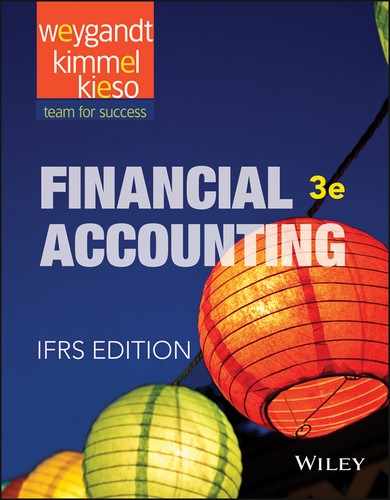CHAPTER 3
Adjusting the Accounts
FEATURE STORY
What Was Your Profit?
The accuracy of the financial reporting system depends on answers to a few fundamental questions: At what point has revenue been recognized? When have expenses really been incurred?
Unfortunately, all too often companies overstate their revenues. For example, during the dot-com boom, most dot-coms earned a large percentage of their revenue from selling advertising space on their websites. To boost reported revenue, some dot-coms began swapping website ad space. Company A would put an ad for its website on company B’s website, and company B would put an ad for its website on company A’s website. No money changed hands, but each company recorded revenue (for the value of the space that it gave the other company on its site). This practice did little to boost net income, and it resulted in no additional cash flow—but it did boost reported revenue. Regulators eventually put an end to this misleading practice.
Another type of transgression results from companies recording revenues or expenses in the wrong year. In fact, shifting revenues and expenses is one of the most common abuses of financial accounting. For example, here is a sample of British companies that have recently disclosed issues regarding revenue recognition: the Nigerian unit of candy company Cadbury (GBR); vehicle and accident management company Helphire (GBR), which appeared to overstate the amount it was due in reimbursement from insurance companies; and Alterian (GBR), a software firm that specializes in social media, email, and web content management and analytics.
Perhaps one of the most unusual cases of reporting expenses in the wrong period was revealed by Olympus Corporation (JPN). The company admitted that it had covered up investment losses for more than a decade. It then tried to eliminate the losses from the books through a fraudulent process of overstating the price of some acquired assets and then writing down those assets in subsequent adjusting entries.
Unfortunately, revelations such as these have become all too common in the corporate world. It is no wonder that a survey of affluent investors reported that 85% of respondents believed that there should be tighter regulation of financial disclosures; 66% said they did not trust the management of publicly traded companies.
Why do so many companies violate basic financial reporting rules and sound ethics? Many speculate that executives are under increasing pressure to meet higher and higher earnings expectations. If actual results aren’t as good as hoped for, some give in to temptation and “adjust” their numbers to meet market expectations.
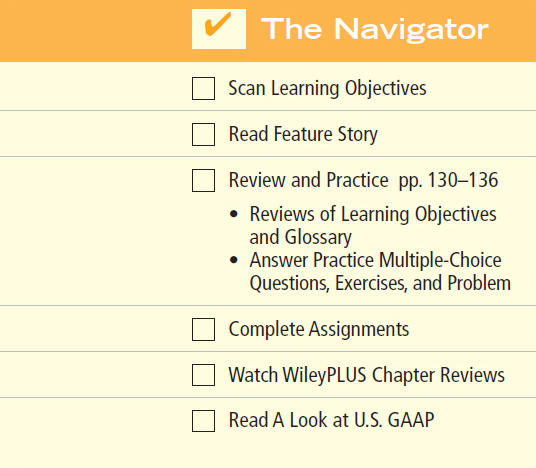

PREVIEW OF CHAPTER 3
In Chapter 1, you learned a neat little formula: . In Chapter 2, you learned some rules for recording revenue and expense transactions. Guess what? Things are not really that nice and neat. In fact, it is often difficult for companies to determine in what time period they should report some revenues and expenses. In other words, in measuring net income, timing is everything.
The content and organization of Chapter 3 are as follows.

 The Navigator
The Navigator
Timing Issues
Learning Objective 1
Explain the time period assumption.
If we could wait to prepare financial statements until a company ended its operations, no adjustments would be needed. At that point, we could easily determine its final statement of financial position and the amount of lifetime income it earned.
However, most companies need immediate feedback about how well they are doing. For example, management usually wants monthly financial statements, and taxing agencies require all businesses to file annual tax returns. Therefore, accountants divide the economic life of a business into artificial time periods. This convenient assumption is referred to as the time period assumption.
Many business transactions affect more than one of these arbitrary time periods. For example, the airplanes purchased by Cathay Pacific (HKG) five years ago are still in use today. We must determine the relevance of each business transaction to specific accounting periods. (How much of the cost of an airplane contributed to operations this year?)
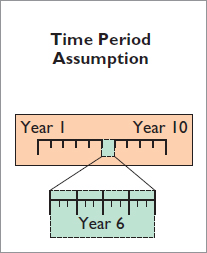
Fiscal and Calendar Years
Both small and large companies prepare financial statements periodically in order to assess their financial condition and results of operations. Accounting time periods are generally a month, a quarter, or a year. Monthly and quarterly time periods are called interim periods. Most large companies must prepare both quarterly and annual financial statements.
An accounting time period that is one year in length is a fiscal year. A fiscal year usually begins with the first day of a month and ends 12 months later on the last day of a month. Many businesses use the calendar year (January 1 to December 31) as their accounting period. Some do not, such as Vodafone Group’s (GBR) fiscal year which ends March 31. Further, sometimes a company’s year-end will vary from year to year. For example, JJB Sports’ (GBR) fiscal year ends on the Sunday that falls closest before January 31, resulting in accounting periods of either 52 or 53 weeks.
• Alternative Terminology
The time period assumption is also called the periodicity assumption.
Accrual- versus Cash-Basis Accounting
Learning Objective 2
Explain the accrual basis of accounting.
What you will learn in this chapter is accrual-basis accounting. Under the accrual basis, companies record transactions that change a company’s financial statements in the periods in which the events occur. For example, using the accrual basis to determine net income means companies recognize revenues when they perform the services (rather than when they receive cash). It also means recognizing expenses when incurred (rather than when paid).
An alternative to the accrual basis is the cash basis. Under cash-basis accounting, companies record revenue when they receive cash. They record an expense when they pay out cash. The cash basis seems appealing due to its simplicity, but it often produces misleading financial statements. It fails to record revenue for a company that has performed services but for which the company has not received the cash. As a result, the cash basis does not match expenses with revenues.
Accrual-basis accounting is therefore in accordance with International Financial Reporting Standards (IFRS). Individuals and some small companies, however, do use cash-basis accounting. The cash basis is justified for small businesses because they often have few receivables and payables. Medium and large companies use accrual-basis accounting.
Recognizing Revenues and Expenses
It can be difficult to determine when to report revenues and expenses. The revenue recognition principle and the expense recognition principle help in this task.
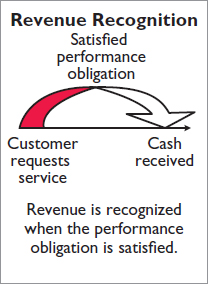
REVENUE RECOGNITION PRINCIPLE
When a company agrees to perform a service or sell a product to a customer, it has a performance obligation. When the company meets this performance obligation, it recognizes revenue. The revenue recognition principle therefore requires that companies recognize revenue in the accounting period in which the performance obligation is satisfied. To illustrate, assume that Soon’s Dry Cleaning cleans clothing on June 30, but customers do not claim and pay for their clothes until the first week of July. Soon’s should record revenue in June when it performed the service (satisfied the performance obligation) rather than in July when it received the cash. At June 30, Soon’s would report a receivable on its statement of financial position and revenue in its income statement for the service performed.
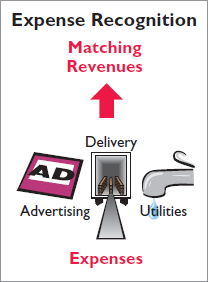
EXPENSE RECOGNITION PRINCIPLE
Accountants follow a simple rule in recognizing expenses: “Let the expenses follow the revenues.” Thus, expense recognition is tied to revenue recognition. In the dry cleaning example, this means that Soon’s should report the salary expense incurred in performing the June 30 cleaning service in the same period in which it recognizes the service revenue. The critical issue in expense recognition is when the expense makes its contribution to revenue. This may or may not be the same period in which the expense is paid. If Soon’s does not pay the salary incurred on June 30 until July, it would report salaries payable on its June 30 statement of financial position.
This practice of expense recognition is referred to as the expense recognition principle (often referred to as the matching principle). It dictates that efforts (expenses) be matched with results (revenues). Illustration 3-1 summarizes the revenue and expense recognition principles.
Illustration 3-1 IFRS relationships in revenue and expense recognition
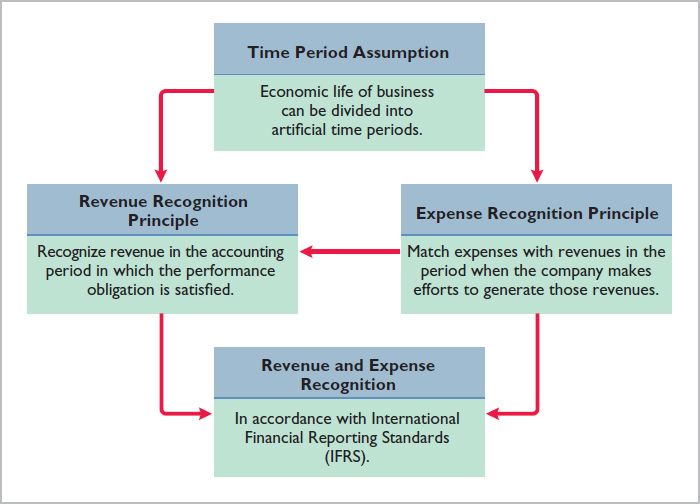
• HELPFUL HINT
Recognize means to record or to report.
The Basics of Adjusting Entries
Learning Objective 3
Explain the reasons for adjusting entries.
In order for revenues to be recorded in the period in which services are performed, and for expenses to be recognized in the period in which they are incurred, companies make adjusting entries. Adjusting entries ensure that the revenue recognition and expense recognition principles are followed.
Adjusting entries are necessary because the trial balance—the first pulling together of the transaction data—may not contain up-to-date and complete data. This is true for several reasons:
- Some events are not recorded daily because it is not efficient to do so. Examples are the use of supplies and the earning of wages by employees.
- Some costs are not recorded during the accounting period because these costs expire with the passage of time rather than as a result of recurring daily transactions. Examples are charges related to the use of buildings and equipment, rent, and insurance.
- Some items may be unrecorded. An example is a utility service bill that will not be received until the next accounting period.
Adjusting entries are required every time a company prepares financial statements. The company analyzes each account in the trial balance to determine whether it is complete and up-to-date for financial statement purposes. Every adjusting entry will include one income statement account and one statement of financial position account.
Types of Adjusting Entries
Learning Objective 4
Identify the major types of adjusting entries.
Adjusting entries are classified as either deferrals or accruals. As Illustration 3-2 shows, each of these classes has two subcategories.
Illustration 3-2 Categories of adjusting entries
Deferrals:
- Prepaid expenses: Expenses paid in cash before they are used or consumed.
- Unearned revenues: Cash received before services are performed.
Accruals:
- Accrued revenues: Revenues for services performed but not yet received in cash or recorded.
- Accrued expenses: Expenses incurred but not yet paid in cash or recorded.
Subsequent sections give examples of each type of adjustment. Each example is based on the October 31 trial balance of Yazici Advertising A.Ş. from Chapter 2, reproduced in Illustration 3-3.
Illustration 3-3 Trial balance
| YAZICI ADVERTISING A.Ş. Trial Balance October 31, 2017 |
||
| Debit | Credit | |
| Cash | ||
| Supplies | 2,500 |
|
| Prepaid Insurance | 600 |
|
| Equipment | 5,000 |
|
| Notes Payable | ||
| Accounts Payable | 2,500 |
|
| Unearned Service Revenue | 1,200 |
|
| Share Capital—Ordinary | 10,000 |
|
| Retained Earnings | –0– |
|
| Dividends | 500 |
|
| Service Revenue | 10,000 |
|
| Salaries and Wages Expense | 4,000 |
|
| Rent Expense | 900 |
|
We assume that Yazici uses an accounting period of one month. Thus, monthly adjusting entries are made. The entries are dated October 31.
Adjusting Entries for Deferrals
Learning Objective 5
Prepare adjusting entries for deferrals.
To defer means to postpone or delay. Deferrals are expenses or revenues that are recognized at a date later than the point when cash was originally exchanged. Companies make adjusting entries for deferrals to record the portion of the deferred item that was incurred as an expense or recognized as revenue during the current accounting period. The two types of deferrals are prepaid expenses and unearned revenues.
PREPAID EXPENSES
When companies record payments of expenses that will benefit more than one accounting period, they record an asset called prepaid expenses or prepayments. When expenses are prepaid, an asset account is increased (debited) to show the service or benefit that the company will receive in the future. Examples of common prepayments are insurance, supplies, advertising, and rent. In addition, companies make prepayments when they purchase buildings and equipment.
Prepaid expenses are costs that expire either with the passage of time (e.g., rent and insurance) or through use (e.g., supplies). The expiration of these costs does not require daily entries, which would be impractical and unnecessary. Accordingly, companies postpone the recognition of such cost expirations until they prepare financial statements. At each statement date, they make adjusting entries to record the expenses applicable to the current accounting period and to show the remaining amounts in the asset accounts.
Prior to adjustment, assets are overstated and expenses are understated. Therefore, as shown in Illustration 3-4, an adjusting entry for prepaid expenses results in an increase (a debit) to an expense account and a decrease (a credit) to an asset account.
Illustration 3-4 Adjusting entries for prepaid expenses

Let’s look in more detail at some specific types of prepaid expenses, beginning with supplies.
SUPPLIES The purchase of supplies, such as paper and envelopes, results in an increase (a debit) to an asset account. During the accounting period, the company uses supplies. Rather than record supplies expense as the supplies are used, companies recognize supplies expense at the end of the accounting period. At the end of the accounting period, the company counts the remaining supplies. The difference between the unadjusted balance in the Supplies (asset) account and the actual cost of supplies on hand represents the supplies used (an expense) for that period.

Recall from Chapter 2 that Yazici Advertising purchased supplies costing ![]() 2,500 on October 5. Yazici recorded the purchase by increasing (debiting) the asset Supplies. This account shows a balance of
2,500 on October 5. Yazici recorded the purchase by increasing (debiting) the asset Supplies. This account shows a balance of ![]() 2,500 in the October 31 trial balance. An inventory count at the close of business on October 31 reveals that
2,500 in the October 31 trial balance. An inventory count at the close of business on October 31 reveals that ![]() 1,000 of supplies are still on hand. Thus, the cost of supplies used is
1,000 of supplies are still on hand. Thus, the cost of supplies used is ![]() 1,500 (
1,500 (![]() 2,500 −
2,500 − ![]() 1,000). This use of supplies decreases an asset, Supplies. It also decreases equity by increasing an expense account, Supplies Expense. This is shown in Illustration 3-5.
1,000). This use of supplies decreases an asset, Supplies. It also decreases equity by increasing an expense account, Supplies Expense. This is shown in Illustration 3-5.
Illustration 3-5 Adjustment for supplies

After adjustment, the asset account Supplies shows a balance of ![]() 1,000, which is equal to the cost of supplies on hand at the statement date. In addition, Supplies Expense shows a balance of
1,000, which is equal to the cost of supplies on hand at the statement date. In addition, Supplies Expense shows a balance of ![]() 1,500, which equals the cost of supplies used in October. If Yazici does not make the adjusting entry, October expenses are understated and net income is overstated by
1,500, which equals the cost of supplies used in October. If Yazici does not make the adjusting entry, October expenses are understated and net income is overstated by ![]() 1,500. Moreover, both assets and equity will be overstated by
1,500. Moreover, both assets and equity will be overstated by ![]() 1,500 on the October 31 statement of financial position.
1,500 on the October 31 statement of financial position.
INSURANCE Companies purchase insurance to protect themselves from losses due to fire, theft, and unforeseen events. Insurance must be paid in advance, often for more than one year. The cost of insurance (premiums) paid in advance is recorded as an increase (debit) in the asset account Prepaid Insurance. At the financial statement date, companies increase (debit) Insurance Expense and decrease (credit) Prepaid Insurance for the cost of insurance that has expired during the period.
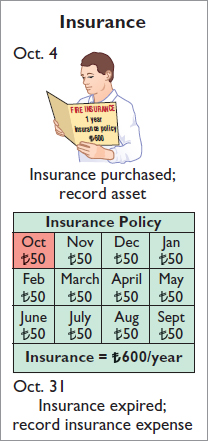
On October 4, Yazici Advertising paid ![]() 600 for a one-year fire insurance policy. Coverage began on October 1. Yazici recorded the payment by increasing (debiting) Prepaid Insurance. This account shows a balance of
600 for a one-year fire insurance policy. Coverage began on October 1. Yazici recorded the payment by increasing (debiting) Prepaid Insurance. This account shows a balance of ![]() 600 in the October 31 trial balance. Insurance of
600 in the October 31 trial balance. Insurance of ![]() 50 (
50 (![]() 600 ÷ 12) expires each month. The expiration of prepaid insurance decreases an asset, Prepaid Insurance. It also decreases equity by increasing an expense account, Insurance Expense.
600 ÷ 12) expires each month. The expiration of prepaid insurance decreases an asset, Prepaid Insurance. It also decreases equity by increasing an expense account, Insurance Expense.
As shown in Illustration 3-6 (page 108), the asset Prepaid Insurance shows a balance of 550, which represents the unexpired cost for the remaining 11 months of coverage. At the same time, the balance in Insurance Expense equals the insurance cost that expired in October. If Yazici does not make this adjustment, October expenses are understated by ![]() 50 and net income is overstated by
50 and net income is overstated by ![]() 50. Moreover, both assets and equity will be overstated by 50 on the October 31 statement of financial position.
50. Moreover, both assets and equity will be overstated by 50 on the October 31 statement of financial position.
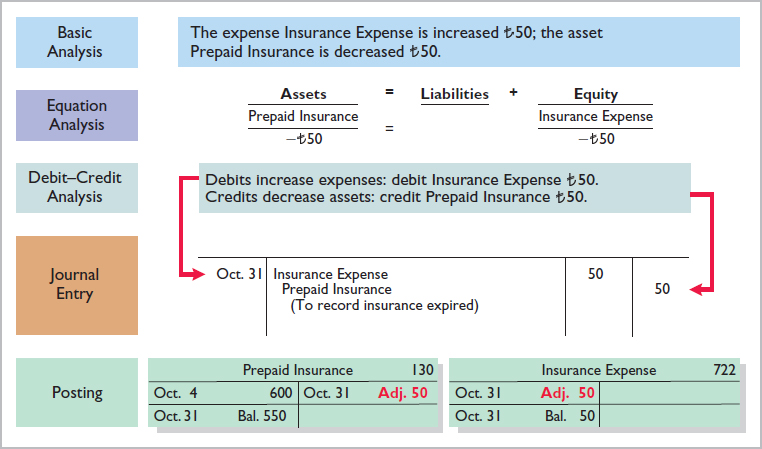
Illustration 3-6 Adjustment for insurance
DEPRECIATION A company typically owns a variety of assets that have long lives, such as buildings, equipment, and motor vehicles. The period of service is referred to as the useful life of the asset. Because a building is expected to be of service for many years, it is recorded as an asset, rather than an expense, on the date it is acquired. As explained in Chapter 1, companies record such assets at cost, as required by the historical cost principle. To follow the expense recognition principle, companies allocate a portion of this cost as an expense during each period of the asset’s useful life. Depreciation is the process of allocating the cost of an asset to expense over its useful life.
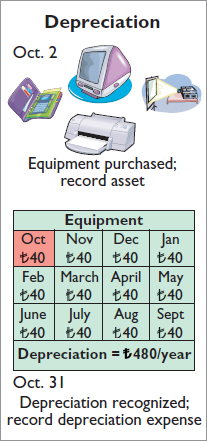
Need for Adjustment. The acquisition of long-lived assets is essentially a long-term prepayment for the use of an asset. An adjusting entry for depreciation is needed to recognize the cost that has been used (an expense) during the period and to report the unused cost (an asset) at the end of the period. One very important point to understand: Depreciation is an allocation concept, not a valuation concept. That is, depreciation allocates an asset’s cost to the periods in which it is used. Depreciation does not attempt to report the actual change in the value of the asset.
For Yazici Advertising, assume that depreciation on the equipment is ![]() 480 a year, or
480 a year, or ![]() 40 per month. As shown in Illustration 3-7 on the next page, rather than decrease (credit) the asset account directly, Yazici instead credits Accumulated Depreciation—Equipment. Accumulated Depreciation is called a contra asset account. Such an account is offset against an asset account on the statement of financial position. Thus, the Accumulated Depreciation—Equipment account offsets the asset account Equipment. This account keeps track of the total amount of depreciation expense taken over the life of the asset. To keep the accounting equation in balance, Yazici decreases equity by increasing an expense account, Depreciation Expense.
40 per month. As shown in Illustration 3-7 on the next page, rather than decrease (credit) the asset account directly, Yazici instead credits Accumulated Depreciation—Equipment. Accumulated Depreciation is called a contra asset account. Such an account is offset against an asset account on the statement of financial position. Thus, the Accumulated Depreciation—Equipment account offsets the asset account Equipment. This account keeps track of the total amount of depreciation expense taken over the life of the asset. To keep the accounting equation in balance, Yazici decreases equity by increasing an expense account, Depreciation Expense.
Illustration 3-7 Adjustment for depreciation

The balance in the Accumulated Depreciation—Equipment account will increase ![]() 40 each month, and the balance in Equipment remains
40 each month, and the balance in Equipment remains ![]() 5,000.
5,000.
Statement Presentation. As indicated, Accumulated Depreciation—Equipment is a contra asset account. It is offset against Equipment on the statement of financial position. The normal balance of a contra asset account is a credit. A theoretical alternative to using a contra asset account would be to decrease (credit) the asset account by the amount of depreciation each period. But using the contra account is preferable for a simple reason: It discloses both the original cost of the equipment and the total cost that has been expensed to date. Thus, in the statement of financial position, Yazici deducts Accumulated Depreciation—Equipment from the related asset account, as shown in Illustration 3-8.
• HELPFUL HINT
All contra accounts have increases, decreases, and normal balances opposite to the account to which they relate.
Illustration 3-8 Statement of financial position presentation of accumulated depreciation
| Equipment | |
| Less: Accumulated depreciation—equipment | 40 |
• Alternative Terminology Book value is also referred to as carrying value.
Book value is the difference between the cost of any depreciable asset and its related accumulated depreciation. In Illustration 3-8, the book value of the equipment at the statement of financial position date is ![]() 4,960. The book value and the fair value of the asset are generally two different values. As noted earlier, the purpose of depreciation is not valuation but a means of cost allocation.
4,960. The book value and the fair value of the asset are generally two different values. As noted earlier, the purpose of depreciation is not valuation but a means of cost allocation.
Depreciation expense identifies the portion of an asset’s cost that expired during the period (in this case, in October). Without this adjusting entry, assets, equity, and net income are overstated by ![]() 40 and depreciation expense is understated by
40 and depreciation expense is understated by ![]() 40.
40.
Illustration 3-9 summarizes the accounting for prepaid expenses.
Illustration 3-9 Accounting for prepaid expenses
| ACCOUNTING FOR PREPAID EXPENSES | |||
| Examples | Reason for Adjustment | Accounts Before Adjustment | Adjusting Entry |
| Insurance, supplies, advertising, rent, depreciation | Prepaid expenses recorded in asset accounts have been used. | Assets overstated. Expenses understated. | Dr. Expenses Cr. Assets or Contra Assets |
UNEARNED REVENUES
When companies receive cash before services are performed, they record a liability by increasing (crediting) a liability account called unearned revenue. In other words, a company now has a performance obligation (liability) to perform a service for one of its customers. Items like rent, magazine subscriptions, and customer deposits for future service may result in unearned revenues. Airlines such as Ryanair (IRL), Qatar Airways (QAT), and Singapore Airlines (SGP), for instance, treat receipts from the sale of tickets as unearned revenue until the flight service is provided.
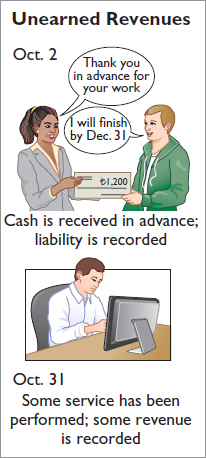
Unearned revenues are the opposite of prepaid expenses. Indeed, unearned revenue on the books of one company is likely to be a prepaid expense on the books of the company that has made the advance payment. For example, if identical accounting periods are assumed, a landlord will have unearned rent revenue when a tenant has prepaid rent.
When a company receives payment for services to be performed in a future accounting period, it increases (credits) an unearned revenue (a liability) account to recognize the liability that exists. The company subsequently recognizes revenues when it performs the service. During the accounting period, it is not practical to make daily entries as the company performs services. Instead, the company delays recognition of revenue until the adjustment process. Then, the company makes an adjusting entry to record the revenue for services performed during the period and to show the liability that remains at the end of the accounting period. Typically, prior to adjustment, liabilities are overstated and revenues are understated. Therefore, as shown in Illustration 3-10, the adjusting entry for unearned revenues results in a decrease (a debit) to a liability account and an increase (a credit) to a revenue account.
Illustration 3-10 Adjusting entries for unearned revenues

• Alternative Terminology
Unearned revenue is sometimes referred to as deferred revenue.
Yazici Advertising received ![]() 1,200 on October 2 from R. Knox for advertising services expected to be completed by December 31. Yazici credited the payment to Unearned Service Revenue. This liability account shows a balance of
1,200 on October 2 from R. Knox for advertising services expected to be completed by December 31. Yazici credited the payment to Unearned Service Revenue. This liability account shows a balance of ![]() 1,200 in the October 31 trial balance. From an evaluation of the services Yazici performed for Knox during October, the company determines that it should recognize
1,200 in the October 31 trial balance. From an evaluation of the services Yazici performed for Knox during October, the company determines that it should recognize ![]() 400 of revenue in October. The liability (Unearned Service Revenue) is therefore decreased, and equity (Service Revenue) is increased.
400 of revenue in October. The liability (Unearned Service Revenue) is therefore decreased, and equity (Service Revenue) is increased.
As shown in Illustration 3-11, the liability Unearned Service Revenue now shows a balance of ![]() 800. That amount represents the remaining advertising services expected to be performed in the future. At the same time, Service Revenue shows total revenue recognized in October of
800. That amount represents the remaining advertising services expected to be performed in the future. At the same time, Service Revenue shows total revenue recognized in October of ![]() 10,400. Without this adjustment, revenues and net income are understated by
10,400. Without this adjustment, revenues and net income are understated by ![]() 400. Moreover, liabilities are overstated and equity is understated by
400. Moreover, liabilities are overstated and equity is understated by ![]() 400 on the October 31 statement of financial position.
400 on the October 31 statement of financial position.
Illustration 3-11 Service revenue accounts after adjustment
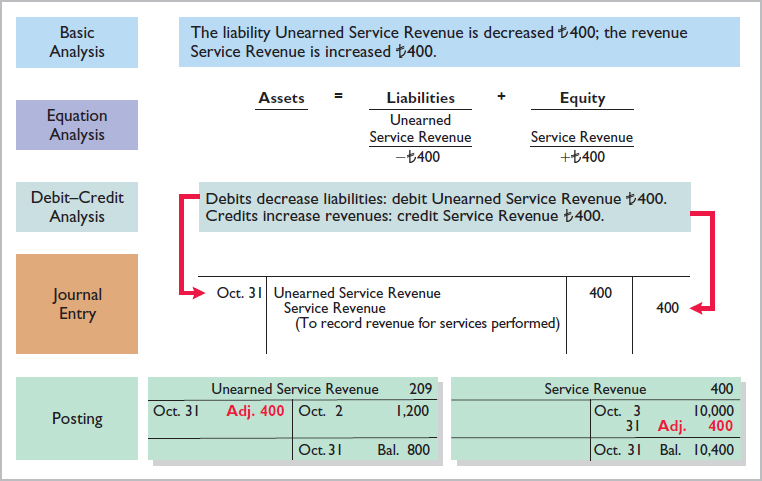
Illustration 3-12 summarizes the accounting for unearned revenues.
Illustration 3-12 Accounting for unearned revenues
| ACCOUNTING FOR UNEARNED REVENUES | |||
| Examples | Reason for Adjustment | Accounts Before Adjustment | Adjusting Entry |
| Rent, magazine subscriptions, customer deposits for future service | Unearned revenues recorded in liability accounts are now recognized as revenue for services performed. | Liabilities overstated. Revenues understated. | Dr. Liabilities Cr. Revenues |
Accounting Across the Organization
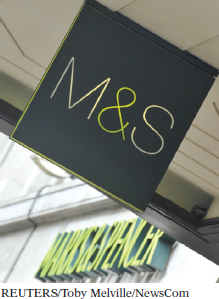
Turning Gift Cards into Revenue
Marks & Spencer plc (GBR)
Those of you who are marketing majors (and even most of you who are not) know that gift cards are among the hottest marketing tools in merchandising today. Customers at stores such as Marks & Spencer plc (GBR) purchase gift cards and give them to someone for later use.
Although these programs are popular with marketing executives, they create accounting questions. Should revenue be recorded at the time the gift card is sold, or when it is exercised? How should expired gift cards be accounted for?
Source: Robert Berner, “Gift Cards: No Gift to Investors,” BusinessWeek (March 14, 2005), p. 86.
Q Suppose that Robert Jones purchases a €100 gift card at Carrefour (FRA) on December 24, 2016, and gives it to his wife, Mary Jones, on December 25, 2016. On January 3, 2017, Mary uses the card to purchase €100 worth of CDs. When do you think Carrefour should recognize revenue and why? (See page 157.)
> DO IT!
Adjusting Entries for Deferrals
The ledger of Zhū Company on March 31, 2017, includes these selected accounts before adjusting entries are prepared.
| Debit | Credit | |
| Prepaid Insurance | ¥ 3,600,000 |
|
| Supplies | 2,800,000 |
|
| Equipment | 25,000,000 |
|
| Accumulated Depreciation—Equipment | ¥5,000,000 |
|
| Unearned Service Revenue | 9,200,000 |
An analysis of the accounts shows the following.
- Insurance expires at the rate of ¥100,000 per month.
- Supplies on hand total ¥800,000.
- The equipment depreciates ¥200,000 a month.
- One-half of the unearned service revenue was performed in March.
Prepare the adjusting entries for the month of March.
Action Plan
- ✓ Make adjusting entries at the end of the period for revenues recognized and expenses incurred in the period.
- ✓ Don’t forget to make adjusting entries for deferrals. Failure to adjust for deferrals leads to overstatement of the asset or liability and understatement of the related expense or revenue.
Solution
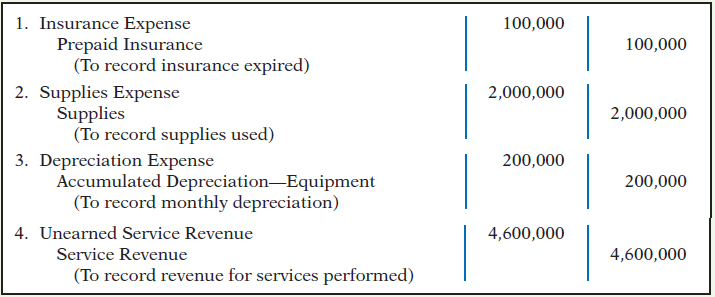
Related exercise material: BE3-3, BE3-4, BE3-5, BE3-6, and DO IT! 3-2.
 The Navigator
The Navigator
Adjusting Entries for Accruals
Learning Objective 6
Prepare adjusting entries for accruals.
The second category of adjusting entries is accruals. Prior to an accrual adjustment, the revenue account (and the related asset account) or the expense account (and the related liability account) are understated. Thus, the adjusting entry for accruals will increase both a statement of financial position and an income statement account.

ACCRUED REVENUES
Revenues for services performed but not yet recorded at the statement date are accrued revenues. Accrued revenues may accumulate (accrue) with the passing of time, as in the case of interest revenue. These are unrecorded because the earning of interest does not involve daily transactions. Companies do not record interest revenue on a daily basis because it is often impractical to do so. Accrued revenues also may result from services that have been performed but not yet billed or collected, as in the case of commissions and fees. These may be unrecorded because only a portion of the total service has been performed and the clients will not be billed until the service has been completed.
An adjusting entry records the receivable that exists at the statement of financial position date and the revenue for the services performed during the period. Prior to adjustment, both assets and revenues are understated. As shown in Illustration 3-13, an adjusting entry for accrued revenues results in an increase (a debit) to an asset account and an increase (a credit) to a revenue account.
Illustration 3-13 Adjusting entries for accrued revenues
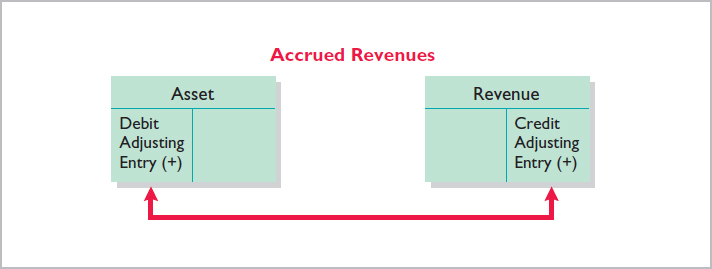
• HELPFUL HINT
For accruals, there may have been no prior entry, and the accounts requiring adjustment may both have zero balances prior to adjustment.
In October, Yazici Advertising performed services worth ![]() 200 that were not billed to clients on or before October 31. Because these services are not billed, they are not recorded. The accrual of unrecorded service revenue increases an asset account, Accounts Receivable. It also increases equity by increasing a revenue account, Service Revenue, as shown in Illustration 3-14.
200 that were not billed to clients on or before October 31. Because these services are not billed, they are not recorded. The accrual of unrecorded service revenue increases an asset account, Accounts Receivable. It also increases equity by increasing a revenue account, Service Revenue, as shown in Illustration 3-14.
Illustration 3-14 Adjustment for accrued revenue
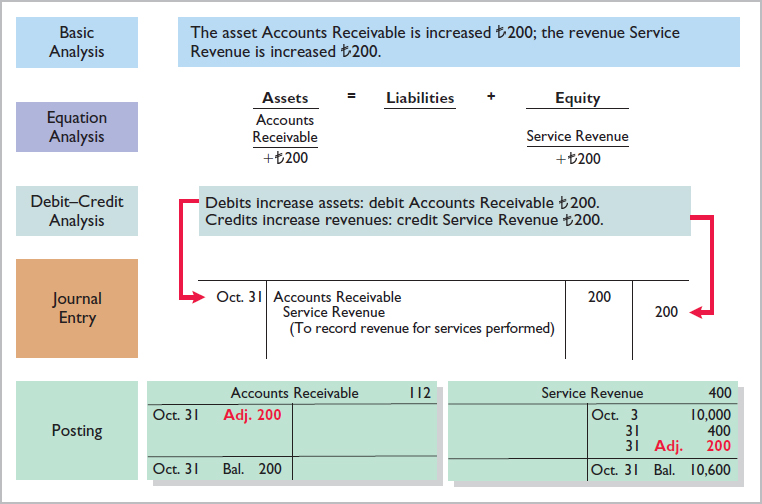
The asset Accounts Receivable shows that clients owe Yazici ![]() 200 at the statement of financial position date. The balance of
200 at the statement of financial position date. The balance of ![]() 10,600 in Service Revenue represents the total revenue for services performed by Yazici during the month (
10,600 in Service Revenue represents the total revenue for services performed by Yazici during the month (![]() 10,000 +
10,000 + ![]() 400 +
400 + ![]() 200). Without the adjusting entry, assets and equity on the statement of financial position and revenues and net income on the income statement are understated.
200). Without the adjusting entry, assets and equity on the statement of financial position and revenues and net income on the income statement are understated.
On November 10, Yazici receives cash of ![]() 200 for the services performed in October and makes the following entry.
200 for the services performed in October and makes the following entry.
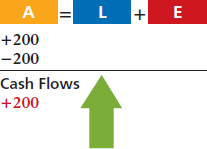

The company records the collection of the receivables by a debit (increase) to Cash and a credit (decrease) to Accounts Receivable.
Illustration 3-15 summarizes the accounting for accrued revenues.
Illustration 3-15 Accounting for accrued revenues
| ACCOUNTING FOR ACCRUED REVENUES | |||
| Examples | Reason for Adjustment | Accounts Before Adjustment | Adjusting Entry |
| Interest, rent, services performed but not collected | Services performed but not yet recorded. | Assets understated. Revenues understated. | Dr. Assets Cr. Revenues |
ACCRUED EXPENSES
Expenses incurred but not yet paid or recorded at the statement date are called accrued expenses. Interest, taxes, and salaries are common examples of accrued expenses.
Companies make adjustments for accrued expenses to record the obligations that exist at the statement of financial position date and to recognize the expenses that apply to the current accounting period. Prior to adjustment, both liabilities and expenses are understated. Therefore, as Illustration 3-16 shows, an adjusting entry for accrued expenses results in an increase (a debit) to an expense account and an increase (a credit) to a liability account.
Illustration 3-16 Adjusting entries for accrued expenses
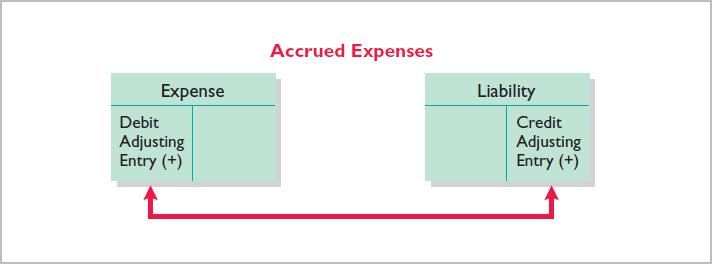
Let’s look in more detail at some specific types of accrued expenses, beginning with accrued interest.
 Ethics Note
Ethics Note
A report released by Fannie Mae’s (USA) board of directors stated that improper adjusting entries at the mortgage-finance company resulted in delayed recognition of expenses caused by interest-rate changes. The motivation for such accounting apparently was the desire to achieve earnings estimates.
ACCRUED INTEREST Yazici Advertising signed a three-month note payable in the amount of ![]() 5,000 on October 1. The note requires Yazici to pay interest at an annual rate of 12%.
5,000 on October 1. The note requires Yazici to pay interest at an annual rate of 12%.
The amount of the interest recorded is determined by three factors: (1) the face value of the note; (2) the interest rate, which is always expressed as an annual rate; and (3) the length of time the note is outstanding. For Yazici, the total interest due on the ![]() 5,000 note at its maturity date three months in the future is
5,000 note at its maturity date three months in the future is ![]() 150 (
150 (![]() 5,000 × 12% × ), or
5,000 × 12% × ), or ![]() 50 for one month. Illustration 3-17 shows the formula for computing interest and its application to Yazici for the month of October.
50 for one month. Illustration 3-17 shows the formula for computing interest and its application to Yazici for the month of October.
Illustration 3-17 Formula for computing interest

• HELPFUL HINT
In computing interest, we express the time period as a fraction of a year.
As Illustration 3-18 (page 116) shows, the accrual of interest at October 31 increases a liability account, Interest Payable. It also decreases equity by increasing an expense account, Interest Expense.
Illustration 3-18 Adjustment for accrued interest

Interest Expense shows the interest charges for the month of October. Interest Payable shows the amount of interest the company owes at the statement date. Yazici will not pay the interest until the note comes due at the end of three months. Companies use the Interest Payable account, instead of crediting Notes Payable, to disclose the two different types of obligations—interest and principal—in the accounts and statements. Without this adjusting entry, liabilities and interest expense are understated, and net income and equity are overstated.
ACCRUED SALARIES AND WAGES Companies pay for some types of expenses, such as employee salaries and wages, after the services have been performed. Yazici paid salaries and wages on October 26 for its employees’ first two weeks of work. The next payment of salaries will not occur until November 9. As Illustration 3-19 shows, three working days remain in October (October 29–31).
Illustration 3-19 Calendar showing Yazici’s pay periods
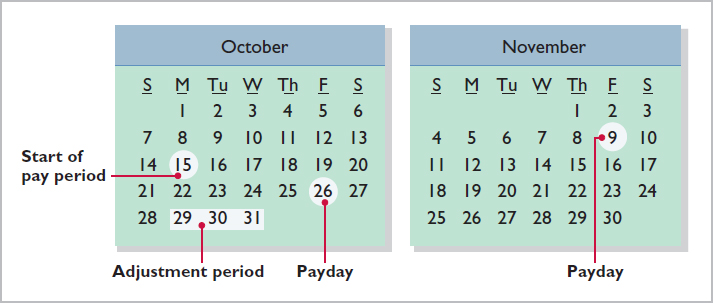
At October 31, the salaries and wages for these three days represent an accrued expense and a related liability to Yazici. The employees receive total salaries and wages of ![]() 2,000 for a five-day work week, or
2,000 for a five-day work week, or ![]() 400 per day. Thus, accrued salaries and wages at October 31 are
400 per day. Thus, accrued salaries and wages at October 31 are ![]() 1,200 (
1,200 (![]() 400 × 3). This accrual increases a liability, Salaries and Wages Payable. It also decreases equity by increasing an expense account, Salaries and Wages Expense, as shown in Illustration 3-20.
400 × 3). This accrual increases a liability, Salaries and Wages Payable. It also decreases equity by increasing an expense account, Salaries and Wages Expense, as shown in Illustration 3-20.
Illustration 3-20 Adjustment for accrued salaries and wages
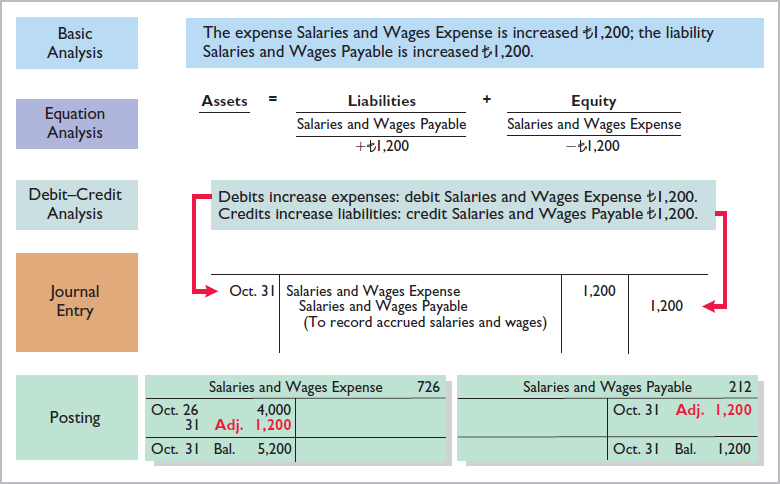
After this adjustment, the balance in Salaries and Wages Expense of ![]() 5,200 (13 days ×
5,200 (13 days × ![]() 400) is the actual salary and wages expense for October. The balance in Salaries and Wages Payable of
400) is the actual salary and wages expense for October. The balance in Salaries and Wages Payable of ![]() 1,200 is the amount of the liability for salaries and wages Yazici owes as of October 31. Without the
1,200 is the amount of the liability for salaries and wages Yazici owes as of October 31. Without the ![]() 1,200 adjustment for salaries and wages, Yazici’s expenses are understated
1,200 adjustment for salaries and wages, Yazici’s expenses are understated ![]() 1,200 and its liabilities are understated
1,200 and its liabilities are understated ![]() 1,200.
1,200.
Yazici pays salaries and wages every two weeks. Consequently, the next payday is November 9, when the company will again pay total salaries and wages of ![]() 4,000. The payment consists of
4,000. The payment consists of ![]() 1,200 of salaries and wages payable at October 31 plus
1,200 of salaries and wages payable at October 31 plus ![]() 2,800 of salaries and wages expense for November (7 working days, as shown in the November calendar ×
2,800 of salaries and wages expense for November (7 working days, as shown in the November calendar × ![]() 400). Therefore, Yazici makes the following entry on November 9.
400). Therefore, Yazici makes the following entry on November 9.
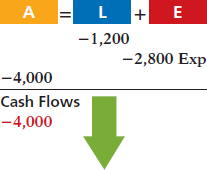

This entry eliminates the liability for Salaries and Wages Payable that Yazici recorded in the October 31 adjusting entry, and it records the proper amount of Salaries and Wages Expense for the period between November 1 and November 9.
Illustration 3-21 summarizes the accounting for accrued expenses.
Illustration 3-21 Accounting for accrued expenses
| ACCOUNTING FOR ACCRUED EXPENSES | |||
| Examples | Reason for Adjustment | Accounts Before Adjustment | Adjusting Entry |
| Interest, rent, salaries | Expenses have been incurred but not yet paid in cash or recorded. | Expenses understated. Liabilities understated. | Dr. Expenses Cr. Liabilities |
People, Planet, and Profit Insight

Got Junk?
Do you have an old computer or two that you no longer use? How about an old TV that needs replacing? Many people do. Approximately 163,000 computers and televisions become obsolete each day. Yet, estimates indicate that only 11% of computers are recycled and 75% of all computers ever sold are sitting in storage somewhere, waiting to be disposed of. Each of these old TVs and computers is loaded with lead, cadmium, mercury, and other toxic chemicals. If you have one of these electronic gadgets, you have a responsibility, and a probable cost, for disposing of it. Companies have the same problem, but their discarded materials may include lead paint, asbestos, and other toxic chemicals.
Q What accounting issue might this cause for companies? (See page 157.)
> DO IT!
Adjusting Entries for Accruals
Micro Computer Services began operations on August 1, 2017. At the end of August 2017, management attempted to prepare monthly financial statements. The following information relates to August. (Amounts are in Chinese yuan.)
- At August 31, the company owed its employees ¥8,000 in salaries and wages that will be paid on September 1.
- On August 1, the company borrowed ¥300,000 from a local bank on a 15-year mortgage. The annual interest rate is 10%.
- Revenue for services performed but unrecorded for August totaled ¥11,000.
Prepare the adjusting entries needed at August 31, 2017.
Action Plan
- ✓ Make adjusting entries at the end of the period for revenues recognized and expenses incurred in the period.
- ✓ Don’t forget to make adjusting entries for accruals. Adjusting entries for accruals will increase both a statement of financial position and an income statement account.
Solution
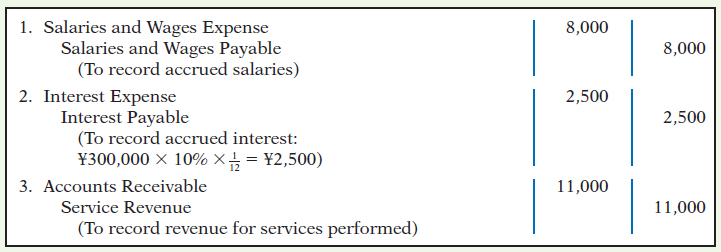
Related exercise material: BE3-7, E3-5, E3-6, E3-7, E3-8, E3-9, E3-10, E3-11, E3-12, and DO IT! 3-3.
 The Navigator
The Navigator
Summary of Basic Relationships
Illustration 3-22 summarizes the four basic types of adjusting entries. Take some time to study and analyze the adjusting entries. Be sure to note that each adjusting entry affects one statement of financial position account and one income statement account.
Illustration 3-22 Summary of adjusting entries
| Type of Adjustment | Accounts Before Adjustment | Adjusting Entry |
| Prepaid expenses | Assets overstated. Expenses understated. |
Dr. Expenses Cr. Assets or Contra Assets |
| Unearned revenues | Liabilities overstated. Revenues understated. |
Dr. Liabilities Cr. Revenues |
| Accrued revenues | Assets understated. Revenues understated. |
Dr. Assets Cr. Revenues |
| Accrued expenses | Expenses understated. Liabilities understated. |
Dr. Expenses Cr. Liabilities |
Illustrations 3-23 (below) and 3-24 (on page 120) show the journalizing and posting of adjusting entries for Yazici Advertising A.Ş. on October 31. The ledger identifies all adjustments by the reference J2 because they have been recorded on page 2 of the general journal. The company may insert a center caption “Adjusting Entries” between the last transaction entry and the first adjusting entry in the journal. When you review the general ledger in Illustration 3-24, note that the entries highlighted in red are the adjustments.
Illustration 3-23 General journal showing adjusting entries
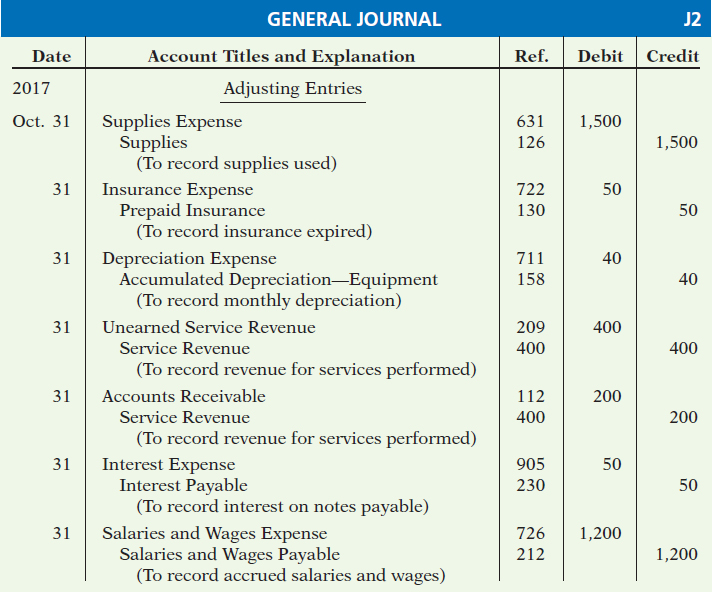
• HELPFUL HINT
- Adjusting entries should not involve debits or credits to cash.
- Evaluate whether the adjustment makes sense. For example, an adjustment to recognize supplies used should increase supplies expense.
- Double-check all computations.
- Each adjusting entry affects one statement of financial position account and one income statement account.
Illustration 3-24 General ledger after adjustment
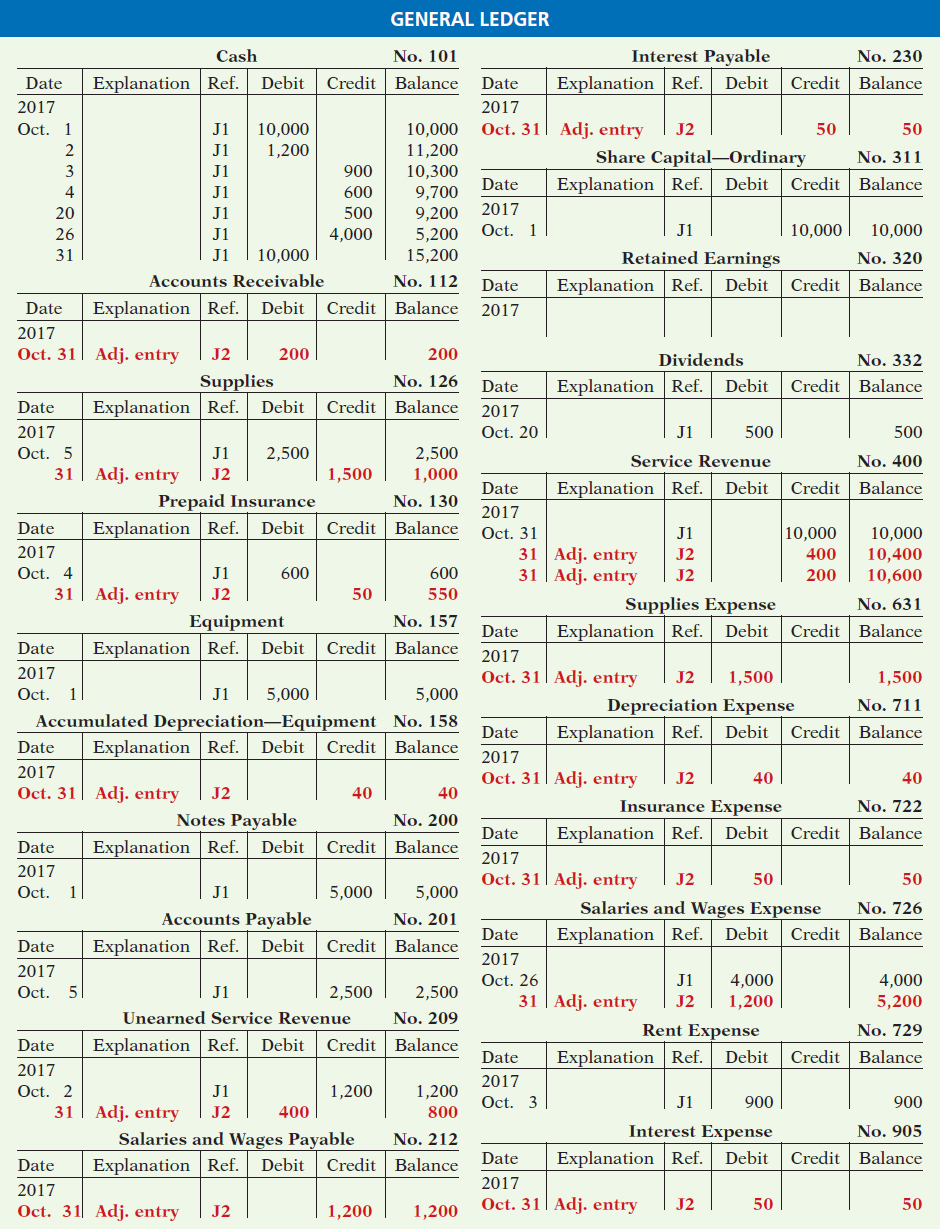
The Adjusted Trial Balance and Financial Statements
Learning Objective 7
Describe the nature and purpose of an adjusted trial balance.
After a company has journalized and posted all adjusting entries, it prepares another trial balance from the ledger accounts. This trial balance is called an adjusted trial balance. It shows the balances of all accounts, including those adjusted, at the end of the accounting period. The purpose of an adjusted trial balance is to prove the equality of the total debit balances and the total credit balances in the ledger after all adjustments. Because the accounts contain all data needed for financial statements, the adjusted trial balance is the primary basis for the preparation of financial statements.
Preparing the Adjusted Trial Balance
Illustration 3-25 presents the adjusted trial balance for Yazici Advertising prepared from the ledger accounts in Illustration 3-24. The amounts affected by the adjusting entries are highlighted in red. Compare these amounts to those in the unadjusted trial balance in Illustration 3-3 on page 105. In this comparison, you will see that there are more accounts in the adjusted trial balance as a result of the adjusting entries made at the end of the month.
Illustration 3-25 Adjusted trial balance
| YAZICI ADVERTISING A.Ş. Adjusted Trial Balance October 31, 2017 |
||
| Debit | Credit | |
| Cash | ||
| Accounts Receivable | 200 |
|
| Supplies | 1,000 |
|
| Prepaid Insurance | 550 |
|
| Equipment | 5,000 |
|
| Accumulated Depreciation—Equipment | ||
| Notes Payable | 5,000 |
|
| Accounts Payable | 2,500 |
|
| Interest Payable | 50 |
|
| Unearned Service Revenue | 800 |
|
| Salaries and Wages Payable | 1,200 |
|
| Share Capital—Ordinary | 10,000 |
|
| Retained Earnings | –0– |
|
| Dividends | 500 |
|
| Service Revenue | 10,600 |
|
| Salaries and Wages Expense | 5,200 |
|
| Supplies Expense | 1,500 |
|
| Rent Expense | 900 |
|
| Insurance Expense | 50 |
|
| Interest Expense | 50 |
|
| Depreciation Expense | 40 |
|
Preparing Financial Statements
Companies can prepare financial statements directly from the adjusted trial balance. Illustrations 3-26 and 3-27 present the interrelationships of data in the adjusted trial balance and the financial statements.
Illustration 3-26 Preparation of the income statement and retained earnings statement from the adjusted trial balance
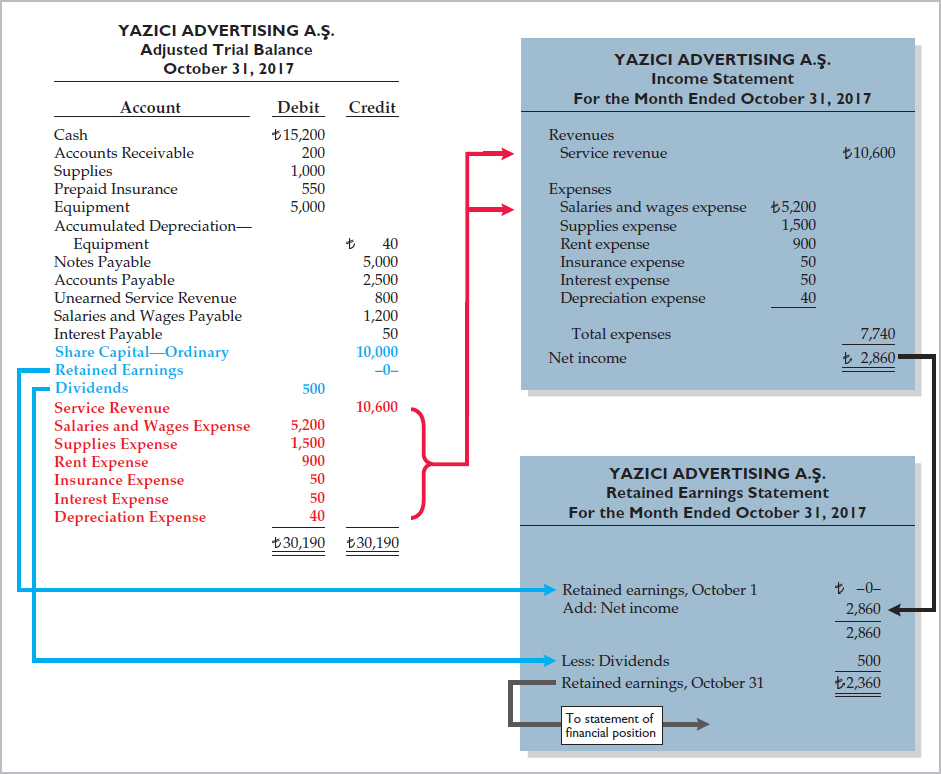
Illustration 3-27 Preparation of the statement of financial position from the adjusted trial balance

As Illustration 3-26 shows, companies prepare the income statement from the revenue and expense accounts. Next, they use the Retained Earnings and Dividends accounts and the net income (or net loss) from the income statement to prepare the retained earnings statement. As Illustration 3-27 shows, companies then prepare the statement of financial position from the asset and liability accounts and the ending retained earnings balance as reported in the retained earnings statement.
> DO IT!
Trial Balance
Kang Company was organized on April 1, 2017. The company prepares quarterly financial statements. The adjusted trial balance amounts at June 30 are shown below. (Amounts are in millions.)
| Debit | Credit | ||
| Cash | Accumulated Depreciation—Equipment | ||
| Accounts Receivable | 600 |
Notes Payable | 5,000 |
| Prepaid Rent | 900 |
Accounts Payable | 1,510 |
| Supplies | 1,000 |
Salaries and Wages Payable | 400 |
| Equipment | 15,000 |
Interest Payable | 50 |
| Dividends | 600 |
Unearned Rent Revenue | 500 |
| Salaries and Wages Expense | 9,400 |
Share Capital—Ordinary | 14,000 |
| Rent Expense | 1,500 |
Service Revenue | 14,200 |
| Depreciation Expense | 850 |
Rent Revenue | 800 |
| Supplies Expense | 200 |
||
| Utilities Expense | 510 |
||
| Interest Expense | 50 |
||
| Total debits | Total credits |
- Determine the net income for the quarter April 1 to June 30.
- Determine the total assets and total liabilities at June 30, 2017, for Kang Company.
- Determine the amount that appears for retained earnings at June 30, 2017.
Action Plan
- ✓ In an adjusted trial balance, make sure all asset, liability, revenue, and expense accounts are properly stated.
- ✓ To determine the ending balance in Retained Earnings, add net income and subtract dividends.
Solution
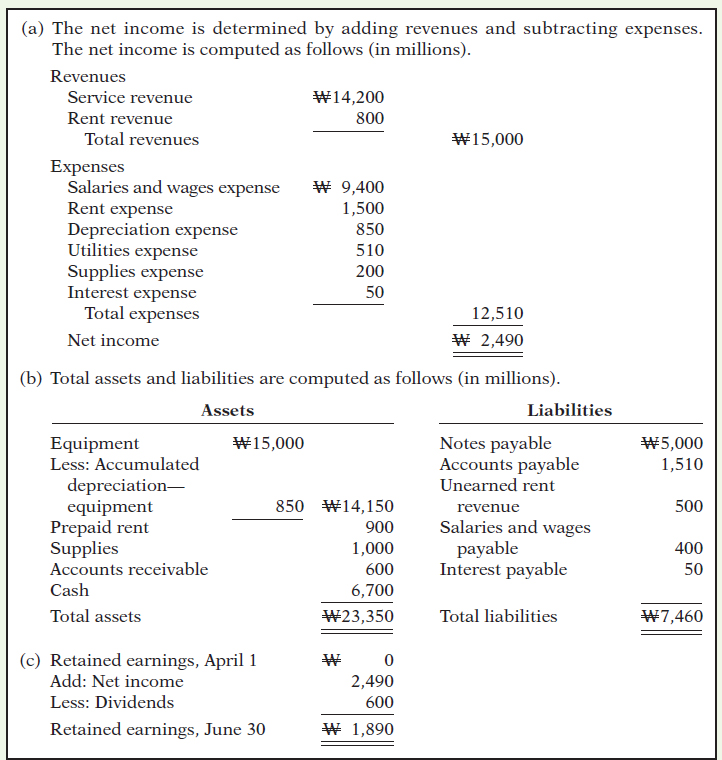
Related exercise material: BE3-9, BE3-10, E3-11, E3-13, and DO IT! 3-4.
 The Navigator
The Navigator
APPENDIX 3A Alternative Treatment of Prepaid Expenses and Unearned Revenues
Learning Objective *8
Prepare adjusting entries for the alternative treatment of deferrals.
In discussing adjusting entries for prepaid expenses and unearned revenues, we illustrated transactions for which companies made the initial entries to statement of financial position accounts. In the case of prepaid expenses, the company debited the prepayment to an asset account. In the case of unearned revenues, the company credited a liability account to record the cash received.
Some companies use an alternative treatment: (1) When a company prepays an expense, it debits that amount to an expense account. (2) When it receives payment for future services, it credits the amount to a revenue account. In this appendix, we describe the circumstances that justify such entries and the different adjusting entries that may be required. This alternative treatment of prepaid expenses and unearned revenues has the same effect on the financial statements as the procedures described in the chapter.
Prepaid Expenses
Prepaid expenses become expired costs either through the passage of time (e.g., insurance) or through consumption (e.g., advertising supplies). If, at the time of purchase, the company expects to consume the supplies before the next financial statement date, it may choose to debit (increase) an expense account rather than an asset account. This alternative treatment is simply more convenient.
Assume that Yazici Advertising A.Ş. expects that it will use before the end of the month all of the supplies purchased on October 5. A debit of ![]() 2,500 to Supplies Expense (rather than to the asset account Supplies) on October 5 will eliminate the need for an adjusting entry on October 31. At October 31, the Supplies Expense account will show a balance of
2,500 to Supplies Expense (rather than to the asset account Supplies) on October 5 will eliminate the need for an adjusting entry on October 31. At October 31, the Supplies Expense account will show a balance of ![]() 2,500, which is the cost of supplies used between October 5 and October 31.
2,500, which is the cost of supplies used between October 5 and October 31.
But what if the company does not use all the supplies? For example, what if an inventory of ![]() 1,000 of advertising supplies remains on October 31? Obviously, the company would need to make an adjusting entry. Prior to adjustment, the expense account Supplies Expense is overstated
1,000 of advertising supplies remains on October 31? Obviously, the company would need to make an adjusting entry. Prior to adjustment, the expense account Supplies Expense is overstated ![]() 1,000, and the asset account Supplies is understated
1,000, and the asset account Supplies is understated ![]() 1,000. Thus, Yazici makes the following adjusting entry.
1,000. Thus, Yazici makes the following adjusting entry.


After the company posts the adjusting entry, the accounts show the following.
Illustration 3A-1 Prepaid expenses accounts after adjustment

After adjustment, the asset account Supplies shows a balance of ![]() 1,000, which is equal to the cost of supplies on hand at October 31. In addition, Supplies Expense shows a balance of
1,000, which is equal to the cost of supplies on hand at October 31. In addition, Supplies Expense shows a balance of ![]() 1,500. This is equal to the cost of supplies used between October 5 and October 31. Without the adjusting entry, expenses are overstated and net income is understated by
1,500. This is equal to the cost of supplies used between October 5 and October 31. Without the adjusting entry, expenses are overstated and net income is understated by ![]() 1,000 in the October income statement. Also, both assets and equity are understated by
1,000 in the October income statement. Also, both assets and equity are understated by ![]() 1,000 on the October 31 statement of financial position.
1,000 on the October 31 statement of financial position.
Illustration 3-29 compares the entries and accounts for advertising supplies in the two adjustment approaches.
Illustration 3A-2 Adjustment approaches—a comparison

After Yazici posts the entries, the accounts appear as follows.
Illustration 3A-3 Comparison of accounts

Note that the account balances under each alternative are the same at October 31: Supplies 1,000 and Supplies Expense ![]() 1,500.
1,500.
Unearned Revenues
Unearned revenues are recognized as revenue at the time services are performed. Similar to the case for prepaid expenses, companies may credit (increase) a revenue account when they receive cash for future services.
To illustrate, assume that Yazici Advertising received ![]() 1,200 for future services on October 2. Yazici expects to perform the services before October 31.1 In such a case, the company credits Service Revenue. If Yazici in fact performs the service before October 31, no adjustment is needed.
1,200 for future services on October 2. Yazici expects to perform the services before October 31.1 In such a case, the company credits Service Revenue. If Yazici in fact performs the service before October 31, no adjustment is needed.
• HELPFUL HINT
The required adjusted balances here are Service Revenue ![]() 400 and Unearned Service Revenue
400 and Unearned Service Revenue ![]() 800.
800.
However, if at the statement date Yazici has not performed ![]() 800 of the services, it would make an adjusting entry. Without the entry, the revenue account Service Revenue is overstated
800 of the services, it would make an adjusting entry. Without the entry, the revenue account Service Revenue is overstated ![]() 800, and the liability account Unearned Service Revenue is understated
800, and the liability account Unearned Service Revenue is understated ![]() 800. Thus, Yazici makes the following adjusting entry.
800. Thus, Yazici makes the following adjusting entry.
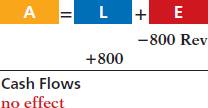

After Yazici posts the adjusting entry, the accounts show the following.
Illustration 3A-4 Unearned service revenue accounts after adjustment

The liability account Unearned Service Revenue shows a balance of ![]() 800. This equals the services that will be performed in the future. In addition, the balance in Service Revenue equals the services performed in October. Without the adjusting entry, both revenues and net income are overstated by
800. This equals the services that will be performed in the future. In addition, the balance in Service Revenue equals the services performed in October. Without the adjusting entry, both revenues and net income are overstated by ![]() 800 in the October income statement. Also, liabilities are understated by
800 in the October income statement. Also, liabilities are understated by ![]() 800, and equity is overstated by
800, and equity is overstated by ![]() 800 on the October 31 statement of financial position.
800 on the October 31 statement of financial position.
Illustration 3-32 compares the entries and accounts for initially recording unearned service revenue in (1) a liability account or (2) a revenue account.
Illustration 3A-5 Adjustment approaches—a comparison
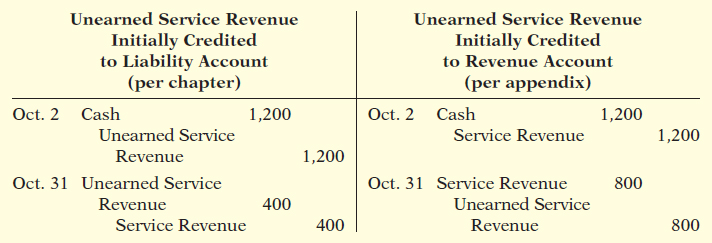
After Yazici posts the entries, the accounts appear as follows.
Illustration 3A-6 Comparison of accounts

Note that the balances in the accounts are the same under the two alternatives: Unearned Service Revenue ![]() 800 and Service Revenue
800 and Service Revenue ![]() 400.
400.
Summary of Additional Adjustment Relationships
Illustration 3-34 provides a summary of basic relationships for deferrals.
Illustration 3A-7 Summary of basic relationships for deferrals
| Type of Adjustment | Reason for Adjustment | Accounts before Adjustment | Adjusting Entry | |
| Prepaid expenses | (a) | Prepaid expenses initially recorded in asset accounts have been used. | Assets overstated. Expenses understated. | Dr. Expenses Cr. Assets |
| (b) | Prepaid expenses initially recorded in expense accounts have not been used. | Assets understated. Expenses overstated. | Dr. Assets Cr. Expenses | |
| Unearned revenues | (a) | Unearned revenues initially recorded in liability accounts are now recognized as revenue. | Liabilities overstated. Revenues understated. | Dr. Liabilities Cr. Revenues |
| (b) | Unearned revenues initially recorded in revenue accounts are still unearned. | Liabilities understated. Revenues overstated. | Dr. Revenues Cr. Liabilities | |
Alternative adjusting entries do not apply to accrued revenues and accrued expenses because no entries occur before companies make these types of adjusting entries.
APPENDIX 3B Concepts in Action
Learning Objective *9
Discuss financial reporting concepts.
This appendix provides a summary of the financial reporting concepts used in this textbook. In addition, it provides other useful concepts that accountants use as a basis for recording and reporting financial information.
Qualities of Useful Information
Recently, the IASB and FASB completed the first phase of a joint project in which they developed a conceptual framework to serve as the basis for future accounting standards. The framework begins by stating that the primary objective of financial reporting is to provide financial information that is useful to investors and creditors for making decisions about providing capital. According to the IASB, useful information should possess two fundamental qualities, relevance and faithful representation, as shown in Illustration 3-35.
Illustration 3B-1 Fundamental qualities of useful information
 |
Relevance Accounting information has relevance if it would make a difference in a business decision. Information is considered relevant if it provides information that has predictive value, that is, helps provide accurate expectations about the future, and has confirmatory value, that is, confirms or corrects prior expectations. Materiality is a company-specific aspect of relevance. An item is material when its size makes it likely to influence the decision of an investor or creditor. |
 |
Faithful Representation Faithful representation means that information accurately depicts what really happened. To provide a faithful representation, information must be complete (nothing important has been omitted), neutral (is not biased toward one position or another), and free from error. |
ENHANCING QUALITIES
In addition to the two fundamental qualities, the IASB and FASB also describe a number of enhancing qualities of useful information. These include comparability, verifiability, timeliness, and understandability. In accounting, comparability results when different companies use the same accounting principles. Another type of comparability is consistency. Consistency means that a company uses the same accounting principles and methods from year to year. Information is verifiable if independent observers, using the same methods, obtain similar results. For accounting information to have relevance, it must be timely. That is, it must be available to decision-makers before it loses its capacity to influence decisions. For example, public companies like SAP (DEU) or Tencent Holdings (CHN) usually provide their annual reports to investors within 60 days of their year-end. Information has the quality of understandability if it is presented in a clear and concise fashion, so that reasonably informed users of that information can interpret it and comprehend its meaning.
Assumptions in Financial Reporting
To develop accounting standards, the IASB relies on some key assumptions, as shown in Illustration 3-36. These include assumptions about the monetary unit, economic entity, time period, and going concern.
Illustration 3B-2 Key assumptions in financial reporting
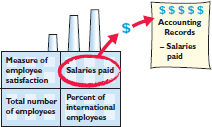 |
Monetary Unit Assumption The monetary unit assumption (discussed in Chapter 1) requires that only those things that can be expressed in money are included in the accounting records. This means that certain important information needed by investors, creditors, and managers, such as customer satisfaction, is not reported in the financial statements. |
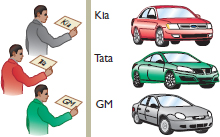 |
Economic Entity Assumption The economic entity assumption (discussed in Chapter 1) states that the activities of the entity must be kept separate and distinct from the activities of the owner. In order to assess a company’s performance and financial position accurately, it is important not to blur company transactions with personal transactions (especially those of its managers) or transactions of other companies. |
 |
Time Period (Periodicity) Assumption Notice that the income statement, retained earnings statement, and statement of cash flows all cover periods of one year, and the statement of financial position is prepared at the end of each year. The time period assumption (discussed in Chapter 3) states that the life of a business can be divided into artificial time periods and that useful reports covering those periods can be prepared for the business. |
 |
Going Concern Assumption The going concern assumption (discussed in Chapter 9) states that the business will remain in operation for the foreseeable future. Of course, many businesses do fail, but in general it is reasonable to assume that the business will continue operating. |
 Ethics Note
Ethics Note
The importance of the economic entity assumption is illustrated by scandals involving Adelphia (USA). In this case, senior company employees entered into transactions that blurred the line between the employees’ financial interests and those of the company. For example, Adelphia guaranteed over $2 billion of loans to the founding family.
Principles in Financial Reporting
MEASUREMENT PRINCIPLES
IFRS generally uses one of two measurement principles, the historical cost principle or the fair value principle. Selection of which principle to follow generally relates to trade-offs between relevance and faithful representation.
HISTORICAL COST PRINCIPLE The historical cost principle (or cost principle, discussed in Chapter 1) dictates that companies record assets at their cost. This is true not only at the time the asset is purchased but also over the time the asset is held. For example, if land that was purchased for €30,000 increases in value to €40,000, it continues to be reported at €30,000.
FAIR VALUE PRINCIPLE The fair value principle (discussed in Chapter 1) indicates that assets and liabilities should be reported at fair value (the price received to sell an asset or settle a liability). Fair value information may be more useful than historical cost for certain types of assets and liabilities. For example, certain investment securities are reported at fair value because market price information is often readily available for these types of assets. In choosing between cost and fair value, two qualities that make accounting information useful for decision-making are used—relevance and faithful representation. In determining which measurement principle to use, the factual nature of cost figures are weighed versus the relevance of fair value. In general, most assets follow the historical cost principle because fair values may not be representationally faithful. Only in situations where assets are actively traded, such as investment securities, is the fair value principle applied.
REVENUE RECOGNITION PRINCIPLE
The revenue recognition principle requires that companies recognize revenue in the accounting period in which the performance obligation is satisfied. As discussed earlier in the chapter, in a service company, revenue is recognized at the time the service is performed. In a merchandising company, the performance obligation is generally satisfied when the goods transfer from the seller to the buyer (discussed in Chapter 4). At this point, the sales transaction is complete and the sales price established.
EXPENSE RECOGNITION PRINCIPLE
The expense recognition principle (often referred to as the matching principle, discussed earlier in the chapter) dictates that efforts (expenses) be matched with results (revenues). Thus, expenses follow revenues.
FULL DISCLOSURE PRINCIPLE
The full disclosure principle (discussed in Chapter 11) requires that companies disclose all circumstances and events that would make a difference to financial statement users. If an important item cannot reasonably be reported directly in one of the four types of financial statements, then it should be discussed in notes that accompany the statements.
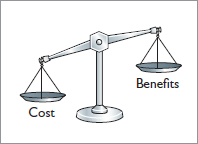
Cost Constraint
Providing information is costly. In deciding whether companies should be required to provide a certain type of information, accounting standard-setters consider the cost constraint. It weighs the cost that companies will incur to provide the information against the benefit that financial statement users will gain from having the information available.
REVIEW AND PRACTICE
LEARNING OBJECTIVES REVIEW
 The Navigator
The Navigator
- Explain the time period assumption. The time period assumption assumes that the economic life of a business is divided into artificial time periods.
- Explain the accrual basis of accounting. Accrual-basis accounting means that companies record events that change a company’s financial statements in the periods in which those events occur, rather than in the periods in which the company receives or pays cash.
- Explain the reasons for adjusting entries. Companies make adjusting entries at the end of an accounting period. Such entries ensure that companies recognize revenues in the period in which the performance obligation is satisfied and recognize expenses in the period in which they are incurred.
- Identify the major types of adjusting entries. The major types of adjusting entries are deferrals (prepaid expenses and unearned revenues) and accruals (accrued revenues and accrued expenses).
- Prepare adjusting entries for deferrals. Deferrals are either prepaid expenses or unearned revenues. Companies make adjusting entries for deferrals to record the portion of the prepayment that represents the expense incurred or the revenue for services performed in the current accounting period.
- Prepare adjusting entries for accruals. Accruals are either accrued revenues or accrued expenses. Companies make adjusting entries for accruals to record revenues for services performed and expenses incurred in the current accounting period that have not been recognized through daily entries.
- Describe the nature and purpose of an adjusted trial balance. An adjusted trial balance shows the balances of all accounts, including those that have been adjusted, at the end of an accounting period. Its purpose is to prove the equality of the total debit balances and total credit balances in the ledger after all adjustments.
- Prepare adjusting entries for the alternative treatment of deferrals. Companies may initially debit prepayments to an expense account. Likewise, they may credit unearned revenues to a revenue account. At the end of the period, these accounts may be overstated. The adjusting entries for prepaid expenses include a debit to an asset account and a credit to an expense account. Adjusting entries for unearned revenues include a debit to a revenue account and a credit to a liability account.
- Discuss financial reporting concepts. To be judged useful, information should have the primary characteristics of relevance and faithful representation. In addition, it should be comparable, consistent, verifiable, timely, and understandable.
The monetary unit assumption requires that companies include in the accounting records only transaction data that can be expressed in terms of money. The economic entity assumption states that economic events can be identified with a particular unit of accountability. The time period assumption states that the economic life of a business can be divided into artificial time periods and that meaningful accounting reports can be prepared for each period. The going concern assumption states that the company will continue in operation long enough to carry out its existing objectives and commitments.
The historical cost principle states that companies should record assets at their cost. The fair value principle indicates that assets and liabilities should be reported at fair value. The revenue recognition principle requires that companies recognize revenue in the accounting period in which the performance obligation is satisfied. The expense recognition principle dictates that efforts (expenses) be matched with results (revenues). The full disclosure principle requires that companies disclose circumstances and events that matter to financial statement users.
The cost constraint weighs the cost that companies incur to provide a type of information against its benefits to financial statement users.
GLOSSARY REVIEW
- Accrual-basis accounting
- Accounting basis in which companies record transactions that change a company’s financial statements in the periods in which the events occur. (p. 102).
- Accruals
- Adjusting entries for either accrued revenues or accrued expenses. (p. 105).
- Accrued expenses
- Expenses incurred but not yet paid in cash or recorded. (p. 114).
- Accrued revenues
- Revenues for services performed but not yet received in cash or recorded. (p. 113).
- Adjusted trial balance
- A list of accounts and their balances after the company has made all adjustments. (p. 121).
- Adjusting entries
- Entries made at the end of an accounting period to ensure that companies follow the revenue and expense recognition principles. (p. 104).
- Book value
- The difference between the cost of a depreciable asset and its related accumulated depreciation. (p. 109).
- Calendar year
- An accounting period that extends from January 1 to December 31. (p. 102).
- Cash-basis accounting
- Accounting basis in which companies record revenue when they receive cash and an expense when they pay out cash. (p. 102).
- *Comparability
- Ability to compare the accounting information of different companies because they use the same accounting principles. (p. 128).
- *Consistency
- Use of the same accounting principles and methods from year to year within a company. (p. 128).
- Contra asset account
- An account offset against an asset account on the statement of financial position. (p. 108).
- *Cost constraint
- Constraint of determining whether the cost that companies will incur to provide the information will outweigh the benefit that financial statement users will gain from having the information available. (p. 130).
- Deferrals
- Adjusting entries for either prepaid expenses or unearned revenues. (p. 105).
- Depreciation
- The allocation of the cost of an asset to expense over its useful life in a rational and systematic manner. (p. 108).
- *Economic entity assumption
- An assumption that every economic entity can be separately identified and accounted for. (p. 129).
- Expense recognition principle (matching principle)
- The principle that companies match efforts (expenses) with accomplishments (revenues). (pp. 103, 130).
- *Fair value principle
- Assets and liabilities should be reported at fair value (the price received to sell an asset or settle a liability). (p. 129).
- *Faithful representation
- Information that accurately depicts what really happened. (p. 128).
- Fiscal year
- An accounting period that is one year in length. (p. 102).
- *Full disclosure principle
- Accounting principle that dictates that companies disclose circumstances and events that make a difference to financial statement users. (p. 130).
- *Going concern assumption
- The assumption that the company will continue in operation for the foreseeable future. (p. 129).
- *Historical cost principle
- An accounting principle that states that companies should record assets at their cost. (p. 129).
- Interim periods
- Monthly or quarterly accounting time periods. (p. 102).
- *Materiality
- A company-specific aspect of relevance. An item is material when its size makes it likely to influence the decision of an investor or creditor. (p. 128).
- *Monetary unit assumption
- An assumption that requires that only those things that can be expressed in money are included in the accounting records. (p. 129).
- Prepaid expenses (prepayments)
- Expenses paid in cash before they are used or consumed. (p. 106).
- *Relevance
- The quality of information that indicates the information makes a difference in a decision. (p. 128).
- Revenue recognition principle
- The principle that companies recognize revenue in the accounting period in which the performance obligation is satisfied. (pp. 103, 130).
- *Timely
- Information that is available to decision-makers before it loses its capacity to influence decisions. (p. 128).
- Time period assumption
- An assumption that accountants can divide the economic life of a business into artificial time periods. (pp. 102, 129).
- *Understandability
- Information presented in a clear and concise fashion so that users can interpret it and comprehend its meaning. (p. 128).
- Unearned revenue
- A liability recorded for cash received before services are performed. (p. 110).
- Useful life
- The length of service of a long-lived asset. (p. 108).
- *Verifiable
- The quality of information that occurs when independent observers, using the same methods, obtain similar results. (p. 128).
PRACTICE MULTIPLE-CHOICE QUESTIONS
- The time period assumption states that:
- companies must wait until the calendar year is completed to prepare financial statements.
- companies use the fiscal year to report financial information.
- the economic life of a business can be divided into artificial time periods.
- companies record information in the time period in which the events occur.
- The revenue recognition principle states that:
- revenue should be recognized in the accounting period in which a performance obligation is satisfied.
- expenses should be matched with revenues.
- the economic life of a business can be divided into artificial time periods.
- the fiscal year should correspond with the calendar year.
- Which of the following statements about the accrual basis of accounting is false?
- Events that change a company’s financial statements are recorded in the periods in which the events occur.
- Revenue is recognized in the period in which services are performed.
- The accrual basis is in accordance with IFRS.
- Revenue is recorded only when cash is received, and expense is recorded only when cash is paid.
- The principle or assumption dictating that efforts (expenses) be matched with accomplishments (revenues) is the:
- expense recognition principle.
- cost assumption.
- time period assumption.
- revenue recognition principle.
- Adjusting entries are made to ensure that:
- expenses are recognized in the period in which they are incurred.
- revenues are recorded in the period in which services are performed.
- statement of financial position and income statement accounts have correct balances at the end of an accounting period.
- All the responses above are correct.
- Each of the following is a major type (or category) of adjusting entries except:
- prepaid expenses.
- accrued revenues.
- accrued expenses.
- recognized revenues.
- The trial balance shows Supplies NT$13,500 and Supplies Expense NT$0. If NT$6,000 of supplies are on hand at the end of the period, the adjusting entry is:

- Adjustments for prepaid expenses:
- decrease assets and increase revenues.
- decrease expenses and increase assets.
- decrease assets and increase expenses.
- decrease revenues and increase assets.
- Accumulated Depreciation is:
- a contra asset account.
- an expense account.
- an equity account.
- a liability account.
- Queenan Company computes depreciation on delivery equipment at HK$10,000 for the month of June. The adjusting entry to record this depreciation is as follows.
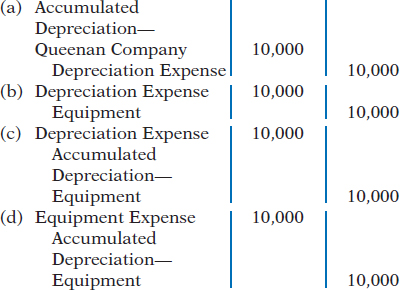
- Adjustments for unearned revenues:
- decrease liabilities and increase revenues.
- have an assets-and-revenues-account relationship.
- increase assets and increase revenues.
- decrease revenues and decrease assets.
- Adjustments for accrued revenues:
- have a liabilities-and-revenues-account relationship.
- have an assets-and-revenues-account relationship.
- decrease assets and revenues.
- decrease liabilities and increase revenues.
- Kathy Siska earned a salary of R$400 for the last week of September. She will be paid on October 1. The adjusting entry for Kathy’s employer at September 30 is:

- Which of the following statements is incorrect concerning the adjusted trial balance?
- An adjusted trial balance proves the equality of the total debit balances and the total credit balances in the ledger after all adjustments are made.
- The adjusted trial balance provides the primary basis for the preparation of financial statements.
- The adjusted trial balance lists the account balances segregated by assets and liabilities.
- The adjusted trial balance is prepared after the adjusting entries have been journalized and posted.
- The trial balance shows Supplies €0 and Supplies Expense €1,500. If €800 of supplies are on hand at the end of the period, the adjusting entry is:
- debit Supplies 800 and credit Supplies Expense 800.
- debit Supplies Expense 800 and credit Supplies 800.
- debit Supplies 700 and credit Supplies Expense 700.
- debit Supplies Expense 700 and credit Supplies 700.
- Neutrality is an ingredient of:
Faithful Representation Relevance (a) Yes Yes (b) No No (c) Yes No (d) No Yes
- Which item is a constraint in financial accounting?
- Comparability.
- Materiality.
- Cost.
- Consistency.
Solutions
- (c) The economic life of a business can be divided into artificial time periods. The other choices are incorrect because (a) companies report their activities on a more frequent basis and not necessarily based on a calendar year; (b) companies report financial information more frequently than annually, such as monthly or quarterly, in order to evaluate results of operations; and (d) this statement describes accrual-basis accounting.
- (a) Revenue should be recognized in the accounting period in which a performance obligation is satisfied. The other choices are incorrect because (b) defines the expense recognition principle, (c) describes the time period assumption, and (d) a company’s fiscal year does not need to correspond with the calendar year.
- (d) Under the accrual basis of accounting, revenue is recognized when the performance obligation is satisfied, not when cash is received, and expense is recognized when incurred, not when cash is paid. The other choices are true statements.
- (a) The expense recognition principle dictates that expenses be matched with revenues. The other choices are incorrect because (b) there is no cost assumption, but the historical cost principle states that assets should be recorded at their cost; (c) the time period assumption states that the economic life of a business can be divided into artificial time periods; and (d) the revenue recognition principle indicates that revenue should be recognized in the accounting period in which a performance obligation is satisfied.
- (d) Adjusting entries are made for the reasons noted in choices (a), (b), and (c). The other choices are true statements, but (d) is the better answer.
- (d) Unearned revenues, not recognized revenues, is one of the major categories of adjusting entries. The other choices all list one of the major categories of adjusting entries.
- (c) Debiting Supplies Expense for NT$7,500 and crediting Supplies for NT$7,500 will decrease Supplies and increase Supplies Expense. The other choices are incorrect because (a) will increase Supplies and decrease Supplies Expense and also for the wrong amounts, (b) will increase Supplies and decrease Supplies Expense, and (d) will cause Supplies to have an incorrect balance of and Supplies Expense to have an incorrect balance of .
- (c) Adjustments for prepaid expenses decrease assets and increase expenses. The other choices are incorrect because an adjusting entry for prepaid expenses (a) increases expenses, not revenues; (b) increases, not decreases, expenses and decreases, not increases, assets; and (d) increases, not decreases, revenues and decreases, not increases, assets.
- (a) Accumulated Depreciation is a contra asset account; it is offset against an asset account on the statement of financial position. The other choices are incorrect because Accumulated Depreciation is not (b) an expense account nor located on the income statement, (c) an equity account, or (d) a liability account.
- (c) The adjusting entry is to debit Depreciation Expense and credit Accumulated Depreciation—Equipment. The other choices are incorrect because (a) the contra asset account title includes the asset being depreciated, not the company name; (b) the credit should be to the contra asset account, not directly to the asset; and (d) the debit for this entry should be Depreciation Expense, not Equipment Expense.
- (a) Adjustments for unearned revenues will consist of a debit (decrease) to unearned revenues (a liability) and a credit (increase) to a revenue account. Choices (b), (c), and (d) are incorrect because adjustments for unearned revenues will increase revenues but will have no effect on assets.
- (b) Adjustments for accrued revenues will have an assets-and-revenues-account relationship. Choices (a) and (d) are incorrect because adjustments for accrued revenues have no effect on liabilities. Choice (c) is incorrect because these adjustments will increase, not decrease, both assets and revenues.
- (b) The adjusting entry should be to debit Salaries and Wages Expense for R$400 and credit Salaries and Wages Payable for R$400. The other choices are incorrect because (a) if an adjusting entry is not made, the amount of money owed (liability) that is shown on the statement of financial position will be understated and the amount of salaries and wages expense will also be understated; (c) the credit account is incorrect as adjusting entries never affect cash; and (d) the debit account should be Salaries and Wages Expense and the credit account should be Salaries and Wages Payable. Adjusting entries never affect cash.
- (c) The accounts on the trial balance can be segregated by the balance in the account—either debit or credit—not whether they are assets or liabilities. All accounts in the ledger are included in the adjusted trial balance, not just assets and liabilities. The other choices are true statements.
- (a) This adjusting entry correctly states the Supplies account at and the Supplies Expense account at . The other choices are incorrect because (b) will cause the Supplies account to have a credit balance (assets have a normal debit balance) and the Supplies Expense account to be stated at €2,300, which is too high; (c) will result in a €700 balance in the Supplies account (€100 too low) and an €800 balance in the Supplies Expense account (€100 too high); and (d) will cause the Supplies account to have a credit balance (assets have a normal debit balance) and the Supplies Expense account to be stated at €2,200, which is too high.
- (c) Neutrality is one of the enhancing qualities that makes information more representationally faithful, not relevant. Therefore, choices (a), (b), and (d) are incorrect.
- (c) Cost is a constraint in financial accounting. The other choices are all enhancing qualities of useful information.
PRACTICE EXERCISES
Prepare adjusting entries.
1. Chen’s Dental Practice opened on January 1, 2017. During the first month of operations, the following transactions occurred.
- Performed services for patients totaling HK$7,850, which has not yet been recorded.
- Utility expenses incurred but not paid prior to January 31 totaled HK$2,500.
- Purchased dental equipment on January 1 for HK$900,000, paying HK$250,000 in cash and signing a HK$650,000 3-year note payable. The equipment depreciates HK$5,000 per month. Interest is HK$5,500 per month.
- Purchased a 1-year malpractice insurance policy on January 1 for HK$150,000.
- Purchased HK$17,000 of dental supplies. On January 31, determined that HK$3,000 of supplies were on hand.
Instructions
Prepare the adjusting entries on January 31. Account titles are Accumulated Depreciation—Equipment, Depreciation Expense, Service Revenue, Accounts Receivable, Insurance Expense, Interest Expense, Interest Payable, Prepaid Insurance, Supplies, Supplies Expense, Utilities Expense, and Utilities Payable.
Solution
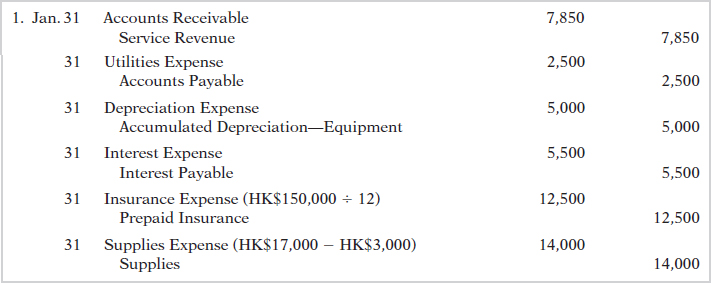
Prepare correct income statement.
2. The income statement of Zhou Ltd. for the month of July shows net income of NT$140,000 based on Service Revenue NT$550,000, Salaries and Wages Expense NT$230,000, Supplies Expense NT$120,000, and Utilities Expense NT$60,000. In reviewing the statement, you discover the following.
- Insurance expired during July of NT$45,000 was omitted.
- Supplies expense includes NT$30,000 of supplies that are still on hand at July 31.
- Depreciation on equipment of NT$18,000 was omitted.
- Accrued but unpaid salaries and wages at July 31 of NT$40,000 were not included.
- Services performed but unrecorded totaled NT$60,000.
Instructions
Prepare a correct income statement for July 2017.
Solution
2.
| ZHOU LTD. Income Statement For the Month Ended July 31, 2017 |
||
| Revenues | ||
| Service revenue (NT$550,000 + NT$60,000) | NT$610,000 |
|
| Expenses | ||
| Salaries and wages expense (NT$230,000 + NT$40,000) | NT$270,000 |
|
| Supplies expense (NT$120,000 − NT$30,000) | 90,000 |
|
| Utilities expense | 60,000 |
|
| Insurance expense | 45,000 |
|
| Depreciation expense | 18,000 |
|
| Total expenses | 483,000 |
|
| Net income | NT$127,000 |
|
PRACTICE PROBLEM
Prepare adjusting entries.
The Green Thumb Lawn Care Ltd. began on April 1. At April 30, the trial balance shows the following balances for selected accounts. (Amounts are in Chinese yuan.)
| Prepaid Insurance | ¥ 36,000 |
| Equipment | 280,000 |
| Notes Payable | 200,000 |
| Unearned Service Revenue | 42,000 |
| Service Revenue | 18,000 |
Analysis reveals the following additional data.
- Prepaid insurance is the cost of a 2-year insurance policy, effective April 1.
- Depreciation on the equipment is ¥5,000 per month.
- The note payable is dated April 1. It is a 6-month, 12% note.
- Seven customers paid for the company’s 6-month lawn service package of ¥6,000 beginning in April. The company performed services for these customers in April.
- Lawn services performed for other customers but not recorded at April 30 totaled ¥15,000.
Instructions
Prepare the adjusting entries for the month of April. Show computations.
Solution
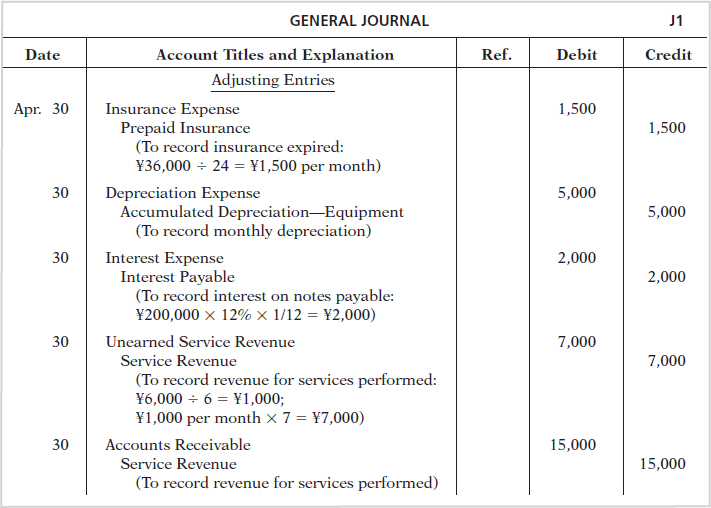
WileyPLUS
Brief Exercises, DO IT! Review, Exercises, and Problems, and many additional resources are available for practice in WileyPLUS.
NOTE: Asterisked Questions, Exercises, and Problems relate to material in the appendices to the chapter.
QUESTIONS
-
How does the time period assumption affect an accountant’s analysis of business transactions?
Explain the terms fiscal year, calendar year, and interim periods.
Define two IFRS principles that relate to adjusting the accounts.
Gabe Corts, a lawyer, accepts a legal engagement in March, performs the work in April, and is paid in May. If Corts’ law firm prepares monthly financial statements, when should it recognize revenue from this engagement? Why?
Why do accrual-basis financial statements provide more useful information than cash-basis statements?
In completing the engagement in Question 3, Corts pays no costs in March, £2,200 in April, and £2,500 in May (incurred in April). How much expense should the firm deduct from revenues in the month when it recognizes the revenue? Why?
“Adjusting entries are required by the historical cost principle of accounting.” Do you agree? Explain.
Why may a trial balance not contain up-to-date and complete financial information?
Distinguish between the two categories of adjusting entries, and identify the types of adjustments applicable to each category.
What is the debit/credit effect of a prepaid expense adjusting entry?
“Depreciation is a valuation process that results in the reporting of the fair value of the asset.” Do you agree? Explain.
Explain the differences between depreciation expense and accumulated depreciation.
Jain Company purchased equipment for Rs18,000,000. By the current statement of financial position date, Rs7,000,000 had been depreciated. Indicate the statement of financial position presentation of the data.
What is the debit/credit effect of an unearned revenue adjusting entry?
A company fails to recognize revenue for services performed but not yet received in cash or recorded. Which of the following accounts are involved in the adjusting entry: (a) asset, (b) liability, (c) revenue, or (d) expense? For the accounts selected, indicate whether they would be debited or credited in the entry.
A company fails to recognize an expense incurred but not paid. Indicate which of the following accounts is debited and which is credited in the adjusting entry: (a) asset, (b) liability, (c) revenue, or (d) expense.
A company makes an accrued revenue adjusting entry for NT$27,000 and an accrued expense adjusting entry for NT$21,000. How much was net income understated prior to these entries? Explain.
On January 9, a company pays €6,000 for salaries and wages, of which €2,000 was reported as Salaries and Wages Payable on December 31. Give the entry to record the payment.
For each of the following items before adjustment, indicate the type of adjusting entry (prepaid expense, unearned revenue, accrued revenue, or accrued expense) that is needed to correct the misstatement. If an item could result in more than one type of adjusting entry, indicate each of the types.
Assets are understated.
Liabilities are overstated.
Liabilities are understated.
Expenses are understated.
Assets are overstated.
Revenue is understated.
One-half of the adjusting entry is given below. Indicate the account title for the other half of the entry.
Salaries and Wages Expense is debited.
Depreciation Expense is debited.
Interest Payable is credited.
Supplies is credited.
Accounts Receivable is debited.
Unearned Service Revenue is debited.
“An adjusting entry may affect more than one statement of financial position or income statement account.” Do you agree? Why or why not?
Why is it possible to prepare financial statements directly from an adjusted trial balance?
L. Thomas Company debits Supplies Expense for all purchases of supplies and credits Rent Revenue for all advanced rentals. For each type of adjustment, give the adjusting entry.
-
What is the primary objective of financial reporting?
Identify the characteristics of useful accounting information.
Dan Fineman, the president of King Company, is pleased. King substantially increased its net income in 2017 while keeping its unit inventory relatively the same. Howard Gross, chief accountant, cautions Dan, however. Gross says that since King changed its method of inventory valuation, there is a consistency problem and it is difficult to determine whether King is better off. Is Gross correct? Why or why not?
What is the distinction between comparability and consistency?
Describe the constraint inherent in the presentation of accounting information.
Laurie Belk is president of Better Books. She has no accounting background. Belk cannot understand why fair value is not used as the basis for all accounting measurement and reporting. Discuss.
What is the economic entity assumption? Give an example of its violation.
BRIEF EXERCISES
Indicate why adjusting entries are needed.
BE3-1 The ledger of Bacalao Company SLU includes the following accounts. Explain why each account may require adjustment.
- Prepaid Insurance.
- Depreciation Expense.
- Unearned Service Revenue.
- Interest Payable.
Identify the major types of adjusting entries.
BE3-2 Lucci Company SpA accumulates the following adjustment data at December 31. Indicate (a) the type of adjustment (prepaid expense, accrued revenue, and so on), and (b) the status of accounts before adjustment (overstated or understated).
- Supplies of €100 are on hand.
- Services performed but not recorded total €870.
- Interest of €200 has accumulated on a note payable.
- Rent collected in advance totaling €560 has been recognized.
Prepare adjusting entry for supplies.
BE3-3 Wow Advertising Company’s trial balance at December 31 shows Supplies £6,700 and Supplies Expense £0. On December 31, there are £1,300 of supplies on hand. Prepare the adjusting entry at December 31 and, using T-accounts, enter the balances in the accounts, post the adjusting entry, and indicate the adjusted balance in each account.
Prepare adjusting entry for depreciation.
BE3-4 At the end of its first year, the trial balance of Zovde Company OAO shows Equipment €32,000 and zero balances in Accumulated Depreciation—Equipment and Depreciation Expense. Depreciation for the year is estimated to be €6,000. Prepare the adjusting entry for depreciation at December 31, post the adjustments to T-accounts, and indicate the statement of financial position presentation of the equipment at December 31.
Prepare adjusting entry for prepaid expense.
BE3-5 On July 1, 2017, Pizner Co. Ltd. pays £13,200 to Orlow Insurance Ltd. for a 3-year insurance contract. Both companies have fiscal years ending December 31. For Pizner Co. Ltd., journalize and post the entry on July 1 and the adjusting entry on December 31.
Prepare adjusting entry for unearned revenue.
BE3-6 Using the data in BE3-5, journalize and post the entry on July 1 and the adjusting entry on December 31 for Orlow Insurance Ltd. Orlow uses the accounts Unearned Service Revenue and Service Revenue.
Prepare adjusting entries for accruals.
BE3-7 The bookkeeper for Malboeuf Company SA asks you to prepare the following accrued adjusting entries at December 31.
- Interest on notes payable of €320 is accrued.
- Services performed but not recorded total €1,750.
- Salaries earned by employees of €900 have not been recorded.
Use the following account titles: Service Revenue, Accounts Receivable, Interest Expense, Interest Payable, Salaries and Wages Expense, and Salaries and Wages Payable.
Analyze accounts in an unadjusted trial balance.
BE3-8 The trial balance of Tiwari Ltd. includes the following statement of financial position accounts, which may require adjustment. For each account that requires adjustment, indicate (a) the type of adjusting entry (prepaid expense, unearned revenue, accrued revenue, or accrued expense) and (b) the related account in the adjusting entry.
| Accounts Receivable | Interest Payable |
| Prepaid Insurance | Unearned Service Revenue |
| Accumulated Depreciation—Equipment |
Prepare an income statement from an adjusted trial balance.
BE3-9 The adjusted trial balance of Kwun Company at December 31, 2017, includes the following accounts (in thousands): Share Capital—Ordinary ![]() 15,600, Dividends
15,600, Dividends ![]() 6,000, Service Revenue
6,000, Service Revenue ![]() 38,400, Salaries and Wages Expense
38,400, Salaries and Wages Expense ![]() 16,000, Insurance Expense
16,000, Insurance Expense ![]() 2,000, Rent Expense
2,000, Rent Expense ![]() 4,400, Supplies Expense
4,400, Supplies Expense ![]() 1,500, and Depreciation Expense
1,500, and Depreciation Expense ![]() 1,300. Prepare an income statement for the year.
1,300. Prepare an income statement for the year.
Prepare a retained earnings statement from an adjusted trial balance.
BE3-10 Partial adjusted trial balance data for Kwun Company is presented in BE3-9. Prepare a retained earnings statement for the year assuming net income is ![]() 13,200 for the year and Retained Earnings is
13,200 for the year and Retained Earnings is ![]() 7,240 on January 1. (Amounts are in thousands.)
7,240 on January 1. (Amounts are in thousands.)
Prepare adjusting entries under alternative treatment of deferrals.
* BE3-11 Lim Company records all prepayments in income statement accounts. At April 30, the trial balance shows Supplies Expense HK$28,000, Service Revenue HK$92,000, and zero balances in related statement of financial position accounts. Prepare the adjusting entries at April 30 assuming (a) HK$11,000 of supplies on hand and (b) HK$20,000 of service revenue should be reported as unearned.
Identify characteristics of useful information.
* BE3-12 The accompanying chart shows the qualitative characteristics of useful accounting information. Fill in the blanks.
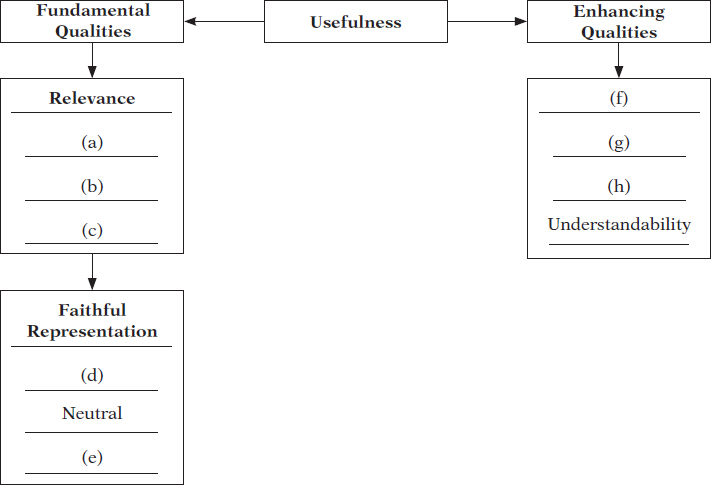
Identify characteristics of useful information.
* BE3-13 Given the characteristics of useful accounting information, complete each of the following statements.
- For information to be _______, it should have predictive value, confirmatory value, and be material.
- _______ is the quality of information that gives assurance that the information accurately depicts what really happened.
- _______ means using the same accounting principles and methods from year to year within a company.
Identify characteristics of useful information.
* BE3-14 Here are some qualitative characteristics of useful accounting information:
- Predictive value
- Neutral
- Verifiable
- Timely
Match each qualitative characteristic to one of the following statements.
- __________ The quality of information that occurs when independent observers, using the same methods, obtain similar results.
- __________ Accounting information must be available to decision-makers before it loses its capacity to influence their decisions.
- __________ Accounting information should help provide accurate expectations about future events.
- __________ Accounting information cannot be selected, prepared, or presented to favor one set of interested users over another.
Define full disclosure principle.
*BE3-15 Select the response that completes the following statement correctly. The full disclosure principle dictates that:
- financial statements should disclose all assets at their cost.
- financial statements should disclose only those events that can be measured in currency.
- financial statements should disclose all events and circumstances that would matter to users of financial statements.
- financial statements should not be relied on unless an auditor has expressed an unqualified opinion on them.
> DO IT! REVIEW
Identify timing concepts.
DO IT! Several timing concepts are discussed on pages 102–103. A list of concepts is provided below in the left column, with descriptions of the concepts in the right column. There are more descriptions provided than concepts. Match the description to the concept.
- ___Cash-basis accounting.
- ___Fiscal year.
- ___Revenue recognition principle.
- ___Expense recognition principle.
- Monthly and quarterly time periods.
- Accountants divide the economic life of a business into artificial time periods.
- Efforts (expenses) should be matched with accomplishments (revenues).
- Companies record revenues when they receive cash and record expenses when they pay out cash.
- An accounting time period that is 1 year in length.
- An accounting time period that starts on January 1 and ends on December 31.
- Companies record transactions in the period in which the events occur.
- Recognize revenue in the accounting period in which a performance obligation is satisfied.
Prepare adjusting entries for deferrals.
DO IT! 3-2 The ledger of Lafayette, SA on March 31, 2017, includes the following selected accounts before adjusting entries.
| Debit | Credit | |
| Prepaid Insurance | 2,400 |
|
| Supplies | 2,500 |
|
| Equipment | 30,000 |
|
| Unearned Service Revenue | 9,000 |
An analysis of the accounts shows the following.
- Insurance expires at the rate of CHF300 per month.
- Supplies on hand total CHF1,400.
- The equipment depreciates CHF200 per month.
- During March, services were performed for two-fifths of the unearned service revenue.
Prepare the adjusting entries for the month of March.
Prepare adjusting entries for accruals.
DO IT! 3-3 Pegasus Computer Services SpA began operations in July 2017. At the end of the month, the company prepares monthly financial statements. Pegasus has the following information for the month.
- At July 31, Pegasus owed employees €1,300 in salaries that the company will pay in August.
- On July 1, Pegasus borrowed €18,000 from a local bank on a 10-year note. The annual interest rate is 7%.
- Service revenue unrecorded in July totaled €2,400.
Prepare the adjusting entries needed at July 31, 2017.
Calculate amounts from trial balance.
DO IT! 3-4 Natal Co. was organized on April 1, 2017. The company prepares quarterly financial statements. The adjusted trial balance amounts at June 30 are shown below.
| Debit | Credit | ||
| Cash | R$ 5,190 |
Accumulated Depreciation—Equipment | R$ 700 |
| Accounts Receivable | 480 |
||
| Prepaid Rent | 720 |
Notes Payable | 4,000 |
| Supplies | 920 |
Accounts Payable | 790 |
| Equipment | 12,000 |
Salaries and Wages Payable | 300 |
| Dividends | 500 |
Interest Payable | 40 |
| Salaries and Wages Expense | 7,400 |
Unearned Rent Revenue | 400 |
| Rent Expense | 1,200 |
Share Capital—Ordinary | 11,200 |
| Depreciation Expense | 700 |
Service Revenue | 11,360 |
| Supplies Expense | 160 |
Rent Revenue | 900 |
| Utilities Expense | 380 |
R$29,690 |
|
| Interest Expense | 40 |
||
R$29,690 |
- Determine the net income for the quarter April 1 to June 30.
- Determine the total assets and total liabilities at June 30, 2017, for Natal Co.
- Determine the amount that appears for Retained Earnings at June 30, 2017.
EXERCISES
Explain the time period assumption.
E3-1 Nish Patel has prepared the following list of statements about the time period assumption.
- Adjusting entries would not be necessary if a company’s life were not divided into artificial time periods.
- The tax authorities require companies to file annual tax returns.
- Accountants divide the economic life of a business into artificial time periods, but each transaction affects only one of these periods.
- Accounting time periods are generally a month, a quarter, or a year.
- A time period lasting one year is called an interim period.
- All fiscal years are calendar years, but not all calendar years are fiscal years.
Instructions
Identify each statement as true or false. If false, indicate how to correct the statement.
Distinguish between cash and accrual basis of accounting.
E3-2 On numerous occasions, proposals have surfaced to put the national governments on the accrual basis of accounting. This is no small issue. If this basis were used, it would mean that billions in unrecorded liabilities would have to be booked, and any deficits would increase substantially.
Instructions ![]()
- What is the difference between accrual-basis accounting and cash-basis accounting?
- Why would politicians prefer the cash basis over the accrual basis?
- Write a letter to your government official explaining why the government should adopt the accrual basis of accounting.
Compute cash and accrual accounting income.
E3-3 Concordia Industries Ltd. collected £112,000 from customers in 2017. Of the amount collected, £30,000 was from revenue accrued from services performed in 2016. In addition, Concordia recorded £44,000 of revenue in 2017, which will not be collected until 2018.
Concordia Industries also paid £72,000 for expenses in 2017. Of the amount paid, £27,000 was for expenses incurred on account in 2016. In addition, Concordia incurred £37,000 of expenses in 2017, which will not be paid until 2018.
Instructions
- Compute 2017 cash-basis net income.
- Compute 2017 accrual-basis net income.
Identify the type of adjusting entry needed.
E3-4 Yilmaz A.Ş. encounters the following situations:
- Yilmaz collects
 1,750 from a customer in 2017 for services to be performed in 2018.
1,750 from a customer in 2017 for services to be performed in 2018. - Yilmaz incurs utility expense which is not yet paid in cash or recorded.
- Yilmaz employees worked 3 days in 2017 but will not be paid until 2018.
- Yilmaz performs services for a customer but has not yet received cash or recorded the transaction.
- Yilmaz paid
 2,400 rent on December 1 for the 4 months starting December 1.
2,400 rent on December 1 for the 4 months starting December 1. - Yilmaz received cash for future services and recorded a liability until the service was performed.
- Yilmaz performed consulting services for a client in December 2017. On December 31, it had not billed the client
 1,200 for these services.
1,200 for these services. - Yilmaz paid cash for an expense and recorded an asset until the item was used up.
- Yilmaz purchased
 750 of supplies in 2017; at year-end,
750 of supplies in 2017; at year-end,  400 of supplies remain unused.
400 of supplies remain unused. - Yilmaz purchased equipment on January 1, 2017; the equipment will be used for 5 years.
- Yilmaz borrowed
 10,000 on October 1, 2017, signing an 8%, 1-year note payable.
10,000 on October 1, 2017, signing an 8%, 1-year note payable.
Instructions
Identify what type of adjusting entry (prepaid expense, unearned revenue, accrued expense, or accrued revenue) is needed in each situation at December 31, 2017.
Prepare adjusting entries from selected data.
E3-5 Hwang Ltd. has the following balances in selected accounts on December 31, 2017.
| Accounts Receivable | NT$ –0– |
| Accumulated Depreciation—Equipment | –0– |
| Equipment | 210,000 |
| Interest Payable | –0– |
| Notes Payable | 240,000 |
| Prepaid Insurance | 63,100 |
| Salaries and Wages Payable | –0– |
| Supplies | 73,500 |
| Unearned Service Revenue | 900,000 |
All the accounts have normal balances. The information below has been gathered at December 31, 2017.
- Hwang borrowed NT$240,000 by signing a 6%, 1-year note on October 1, 2017.
- A count of supplies on December 31, 2017, indicates that supplies of NT$23,400 are on hand.
- Depreciation on the equipment for 2017 is NT$30,000.
- Hwang paid NT$63,000 for 12 months of insurance coverage on June 1, 2017.
- On December 1, 2017, Hwang collected NT$900,000 for consulting services to be performed from December 1, 2017, through March 31, 2018.
- Hwang performed consulting services for a client in December 2017. The client will be billed NT$117,000.
- Hwang pays its employees total salaries of NT$270,000 every Monday for the preceding 5-day week (Monday through Friday). On Monday, December 29, employees were paid for the week ending December 26. All employees worked the last 3 days of 2017.
Instructions
Prepare annual adjusting entries for the seven items described above.
Identify types of adjustments and account relationships.
E3-6 Orwell Company Ltd. accumulates the following adjustment data at December 31.
- Services performed but not recorded total €1,420.
- Supplies of €300 have been used.
- Utility expenses of €225 are unpaid.
- Services related to unearned service revenue of €260 were performed.
- Salaries of €800 are unpaid.
- Prepaid insurance totaling €380 has expired.
Instructions
For each of the above items indicate the following.
- The type of adjustment (prepaid expense, unearned revenue, accrued revenue, or accrued expense).
- The status of accounts before adjustment (overstatement or understatement).
Prepare adjusting entries from selected account data.
E3-7 The ledger of Villa Rental Agency SpA on March 31 of the current year includes the selected accounts, shown below, before adjusting entries have been prepared.
| Debit | Credit | |
| Prepaid Insurance | € 3,600 |
|
| Supplies | 2,800 |
|
| Equipment | 25,000 |
|
| Accumulated Depreciation—Equipment | € 8,400 |
|
| Notes Payable | 20,000 |
|
| Unearned Rent Revenue | 9,900 |
|
| Rent Revenue | 60,000 |
|
| Interest Expense | –0– |
|
| Salaries and Wages Expense | 14,000 |
An analysis of the accounts shows the following.
- The equipment depreciates €320 per month.
- One-third of the unearned rent revenue was earned during the quarter.
- Interest totaling €500 is accrued on the notes payable for the quarter.
- Supplies on hand total €840.
- Insurance expires at the rate of €200 per month.
Instructions
Prepare the adjusting entries at March 31, assuming that adjusting entries are made quarterly. Additional accounts are Depreciation Expense, Insurance Expense, Interest Payable, and Supplies Expense.
Prepare adjusting entries.
E3-8 Kaya Abbas, D.D.S. A.Ş., opened a dental practice on January 1, 2017. During the first month of operations, the following transactions occurred.
- Performed services for patients who had dental plan insurance. At January 31, 875 of such services were performed but not yet recorded.
- Utility expenses incurred but not paid prior to January 31 totaled 520.
- Purchased dental equipment on January 1 for
 80,000, paying
80,000, paying  20,000 in cash and signing a
20,000 in cash and signing a  60,000, 3-year note payable. The equipment depreciates
60,000, 3-year note payable. The equipment depreciates  400 per month. Interest is
400 per month. Interest is  500 per month.
500 per month. - Purchased a six-month malpractice insurance policy on January 1 for
 18,000.
18,000. - Purchased
 1,600 of dental supplies. On January 31, determined that
1,600 of dental supplies. On January 31, determined that  700 of supplies were on hand.
700 of supplies were on hand.
Instructions
Prepare the adjusting entries on January 31. Account titles are Accumulated Depreciation—Equipment, Depreciation Expense, Service Revenue, Accounts Receivable, Insurance Expense, Interest Expense, Interest Payable, Prepaid Insurance, Supplies, Supplies Expense, Utilities Expense, and Utilities Payable.
Prepare adjusting entries.
E3-9 The trial balance for Yazici Advertising A.Ş. is shown in Illustration 3-3 (page 105). Instead of the adjusting entries shown in the text at October 31, assume the following adjustment data.
- Supplies on hand at October 31 total
 800.
800. - Expired insurance for the month is
 100.
100. - Depreciation for the month is
 50.
50. - Services related to unearned service revenue in October worth
 650 were performed.
650 were performed. - Services performed but not billed at October 31 are
 320.
320. - Interest accrued at October 31 is
 70.
70. - Accrued salaries at October 31 are
 1,200.
1,200.
Instructions
Prepare the adjusting entries for the items above.
Prepare correct income statement.
E3-10 The income statement of Bjorn ASA for the month of July shows net income of €1,500 based on Service Revenue €5,500, Salaries and Wages Expense €2,300, Supplies Expense €1,200, and Utilities Expense €500. In reviewing the statement, you discover the following.
- Insurance expired during July of €400 was omitted.
- Supplies expense includes €300 of supplies that are still on hand at July 31.
- Depreciation on equipment of €150 was omitted.
- Accrued but unpaid salaries and wages at July 31 of €280 were not included.
- Services performed but unrecorded totaled €920.
Instructions
Prepare a correct statement for July 2017.
Analyze adjusted data.
E3-11 A partial adjusted trial balance of Rooney Company Ltd. at January 31, 2017, shows the following.
| ROONEY COMPANY LTD. Adjusted Trial Balance January 31, 2017 |
||
| Debit | Credit | |
| Supplies | £ 850 |
|
| Prepaid Insurance | 2,400 |
|
| Salaries and Wages Payable | £ 800 |
|
| Unearned Service Revenue | 750 |
|
| Supplies Expense | 950 |
|
| Insurance Expense | 400 |
|
| Salaries and Wages Expense | 2,500 |
|
| Service Revenue | 2,000 |
|
Instructions
Answer the following questions, assuming the year begins January 1.
- If the amount in Supplies Expense is the January 31 adjusting entry, and £710 of supplies was purchased in January, what was the balance in Supplies on January 1?
- If the amount in Insurance Expense is the January 31 adjusting entry, and the original insurance premium was for 1 year, what was the total premium and when was the policy purchased?
- If £3,100 of salaries was paid in January, what was the balance in Salaries and Wages Payable at December 31, 2016?
Journalize basic transactions and adjusting entries.
E3-12 Selected accounts of Al-Kazaz SJSC are shown below.
| Supplies Expense | ||
| 7/31 | 800 |
|
| Supplies | |||
| 7/1 Bal. | 1,100 |
7/31 |
800 |
| 7/10 | 200 |
||
| Accounts Receivable | ||
| 7/31 | 620 |
|
| Salaries and Wages Expense | ||
| 7/15 | 1,200 |
|
| 7/31 | 1,200 |
|
| Salaries and Wages Payable | ||
7/31 |
1,200 |
|
| Unearned Service Revenue | |||
| 7/31 | 900 |
7/1 Bal. |
1,500 |
7/20 |
750 |
||
| Service Revenue | ||
7/14 |
2,000 |
|
7/31 |
900 |
|
7/31 |
620 |
|
Instructions
After analyzing the accounts, journalize (a) the July transactions and (b) the adjusting entries that were made on July 31. (Hint: July transactions were for cash.)
Prepare adjusting entries from analysis of trial balances.
E3-13 The trial balances before and after adjustment for Matusiak Company OAO at the end of its fiscal year are presented below.
| MATUSIAK COMPANY OAO Trial Balance August 31, 2017 |
||||
| Before Adjustment | After Adjustment | |||
| Dr. | Cr. | Dr. | Cr. | |
| Cash | €10,400 |
€10,400 |
||
| Accounts Receivable | 8,800 |
10,000 |
||
| Supplies | 2,300 |
700 |
||
| Prepaid Insurance | 4,000 |
2,500 |
||
| Equipment | 14,000 |
14,000 |
||
| Accumulated Depreciation—Equipment | € 3,600 |
€ 4,900 |
||
| Accounts Payable | 5,800 |
5,800 |
||
| Salaries and Wages Payable | –0– |
1,100 |
||
| Unearned Rent Revenue | 1,500 |
800 |
||
| Share Capital—Ordinary | 12,000 |
12,000 |
||
| Retained Earnings | 3,600 |
3,600 |
||
| Service Revenue | 34,000 |
35,200 |
||
| Rent Revenue | 11,000 |
11,700 |
||
| Salaries and Wages Expense | 17,000 |
18,100 |
||
| Supplies Expense | –0– |
1,600 |
||
| Rent Expense | 15,000 |
15,000 |
||
| Insurance Expense | –0– |
1,500 |
||
| Depreciation Expense | –0– |
1,300 |
||
€71,500 |
€71,500 |
€75,100 |
€75,100 |
|
Instructions
Prepare the adjusting entries that were made.
Prepare financial statements from adjusted trial balance.
E3-14 The adjusted trial balance for Matusiak Company OAO is given in E3-13.
Instructions
Prepare the income and retained earnings statements for the year and the statement of financial position at August 31.
Record transactions on accrual basis; convert revenue to cash receipts.
E3-15 The following data are taken from the comparative statements of financial position of Newman Billiards Club Ltd., which prepares its financial statements using the accrual basis of accounting.
| December 31 | 2017 | 2016 |
| Accounts receivable from members | £12,000 |
£10,000 |
| Unearned service revenue | 14,000 |
20,000 |
Members are billed based upon their use of the club’s facilities. Unearned service revenues arise from the sale of gift certificates, which members can apply to their future use of club facilities. The 2017 income statement for the club showed that service revenue of £153,000 was recorded during the year.
Instructions
(Hint: You will probably find it helpful to use T-accounts to analyze these data.)
- Prepare journal entries for each of the following events that took place during 2017.
- Accounts receivable from 2016 were all collected.
- Gift certificates outstanding at the end of 2016 were all redeemed.
- An additional £35,000 worth of gift certificates were sold during 2017. A portion of these was used by the recipients during the year; the remainder was still outstanding at the end of 2017.
- Services performed for 2017 were billed to members.
- Accounts receivable for 2017 (i.e., those billed in item [4] above) were partially collected.
- Determine the amount of cash received by the club, with respect to member services, during 2017.
Compute cash flow from operations and net income.
E3-16 In its first year of operations, Kumar Company Ltd. recognized Rs30,000 in service revenue, Rs4,800 of which was on account and still outstanding at year-end. The remaining Rs25,200 was received in cash from customers.
The company incurred operating expenses of Rs17,000. Of these expenses Rs12,000 was paid in cash; Rs5,000 was still owed on account at year-end. In addition, Kumar prepaid Rs2,600 for insurance coverage that would not be used until the second year of operations.
Instructions
- Compute Kumar’s first-year cash flow from operations.
- Compute Kumar’s first-year net income under accrual-basis accounting.
- Which basis of accounting (cash or accrual) provides more useful information for decision-makers?
Journalize adjusting entries.
*E3-17 Visser Company NV has the following balances in selected accounts on December 31, 2017.
| Service Revenue | €40,700 |
| Insurance Expense | 2,880 |
| Supplies Expense | 2,240 |
All the accounts have normal balances. Visser debits prepayments to expense accounts when paid, and credits unearned revenues to revenue accounts when received. The following information below has been gathered at December 31, 2017.
- Visser paid €2,880 for 12 months of insurance coverage on April 1, 2017.
- On December 1, 2017, Visser collected €40,700 for consulting services to be performed from December 1, 2017, through March 31, 2018.
- A count of supplies on December 31, 2017, indicates that supplies of €420 are on hand.
Instructions
Prepare the adjusting entries needed at December 31, 2017.
Journalize transactions and adjusting entries.
*E3-18 At Moretti Company SpA, prepayments are debited to expense when paid, and unearned revenues are credited to revenue when cash is received. During January of the current year, the following transactions occurred.
| Jan. 2 | Paid €2,640 for fire insurance protection for the year. |
10 |
Paid €1,700 for supplies. |
15 |
Received €6,400 for services to be performed in the future. |
On January 31, it is determined that €2,500 of the services were performed and that there are €650 of supplies on hand.
Instructions
- Journalize and post the January transactions. (Use T-accounts.)
- Journalize and post the adjusting entries at January 31.
- Determine the ending balance in each of the accounts.
Identify accounting assumptions and principles.
*E3-19 Presented below are the assumptions and principles discussed in Appendix B.
- Full disclosure principle.
- Going concern assumption.
- Monetary unit assumption.
- Time period assumption.
- Historical cost principle.
- Economic entity assumption.
Instructions
Identify by number the accounting assumption or principle that is described below. Do not use a number more than once.
- __________ Is the rationale for why plant assets are not reported at liquidation value. (Note: Do not use the historical cost principle.)
- __________ Indicates that personal and business record-keeping should be separately maintained.
- __________ Assumes that the monetary unit is the “measuring stick” used to report on financial performance.
- __________ Separates financial information into time periods for reporting purposes.
- __________ Measurement basis used when a reliable estimate of fair value is not available.
- __________ Dictates that companies should disclose all circumstances and events that make a difference to financial statement users.
Identify the assumption or principle that has been violated.
*E3-20 Rosman Co. had three major business transactions during 2017.
- Reported at its fair value of £260,000 merchandise inventory with a cost of £208,000.
- The president of Rosman Co., Jay Rosman, purchased a truck for personal use and charged it to the company’s Salaries and Wages Expense account.
- Rosman Co. wanted to make its 2017 income look better, so it added 2 more weeks to its fiscal year (a 54-week year). Previous fiscal years were 52 weeks.
Instructions
In each situation, identify the assumption or principle that has been violated, if any, and discuss what the company should have done.
Identity financial accounting concepts and principles.
*E3-21 The following characteristics, assumptions, principles, or constraint guide the IASB when it creates accounting standards.
- Relevance
- Faithful representation
- Comparability
- Consistency
- Monetary unit assumption
- Economic entity assumption
- Expense recognition principle
- Time period assumption
- Going concern assumption
- Historical cost principle
- Full disclosure principle
- Materiality
Match each item above with a description below.
- ___Ability to easily evaluate one company’s results relative to another’s.
- ___Belief that a company will continue to operate for the foreseeable future.
- ___The judgment concerning whether an item’s size is large enough to matter to decision-makers.
- ___The reporting of all information that would make a difference to financial statement users.
- ___The practice of preparing financial statements at regular intervals.
- ___The quality of information that indicates the information makes a difference in a decision.
- ___A belief that items should be reported on the statement of financial position at the price that was paid to acquire the item.
- ___A company’s use of the same accounting principles and methods from year to year.
- ___Tracing accounting events to particular companies.
- ___The desire to minimize bias in financial statements.
- ___Reporting only those things that can be measured in monetary units.
- ___Dictates that efforts (expenses) be matched with results (revenues).
Comment on the objectives and qualitative characteristics of accounting information
*E3-22 Net Nanny Software International Ltd., headquartered in Vancouver, specializes in Internet safety and computer security products for both the home and commercial markets. In a recent statement of financial position, it reported a deficit (negative retained earnings) of US$5,678,288. It has reported only net losses since its inception. In spite of these losses, Net Nanny’s ordinary shares have traded anywhere from a high of $3.70 to a low of $0.32 on the Canadian Venture Exchange.
Net Nanny’s financial statements have historically been prepared in Canadian dollars. Recently, the company adopted the U.S. dollar as its reporting currency.
Instructions ![]()
- What is the objective of financial reporting? How does this objective meet or not meet Net Nanny’s investors’ needs?
- Why would investors want to buy Net Nanny’s shares if the company has consistently reported losses over the last few years? Include in your answer an assessment of the relevance of the information reported on Net Nanny’s financial statements.
- Comment on how the change in reporting information from Canadian dollars to U.S. dollars likely affected the readers of Net Nanny’s financial statements. Include in your answer an assessment of the comparability of the information.
Comment on the objectives and qualitative characteristics of financial reporting.
*E3-22 A friend of yours, Ana Gehrig, recently completed an undergraduate degree in science and has just started working with a biotechnology company. Ana tells you that the owners of the business are trying to secure new sources of financing which are needed in order for the company to proceed with development of a new healthcare product. Ana said that her boss told her that the company must put together a report to present to potential investors.
Ana thought that the company should include in this package the detailed scientific findings related to the Phase I clinical trials for this product. She said, “I know that the biotech industry sometimes has only a 10% success rate with new products, but if we report all the scientific findings, everyone will see what a sure success this is going to be! The president was talking about the importance of following some set of accounting principles. Why do we need to look at some accounting rules? What they need to realize is that we have scientific results that are quite encouraging, some of the most talented employees around, and the start of some really great customer relationships. We haven’t made any sales yet, but we will. We just need the funds to get through all the clinical testing and get government approval for our product. Then these investors will be quite happy that they bought in to our company early!”
Instructions ![]()
- What is accounting information?
- Comment on how Ana’s suggestions for what should be reported to prospective investors conforms to the qualitative characteristics of accounting information. Do you think that the things that Ana wants to include in the information for investors will conform to financial reporting guidelines?
PROBLEMS: SET A
Prepare adjusting entries, post to ledger accounts, and prepare adjusted trial balance.
E3-23 Joey Cuono started his own consulting firm, Cuono Company SpA on June 1, 2017. The trial balance at June 30 is shown below.
| CUONO COMPANY SpA Trial Balance June 30, 2017 |
|||
| Account Number | Debit | Credit | |
| 101 | Cash | € 6,200 |
|
| 112 | Accounts Receivable | 6,000 |
|
| 126 | Supplies | 1,600 |
|
| 130 | Prepaid Insurance | 3,000 |
|
| 157 | Equipment | 14,400 |
|
| 201 | Accounts Payable | € 4,700 |
|
| 209 | Unearned Service Revenue | 4,000 |
|
| 311 | Share Capital—Ordinary | 20,000 |
|
| 400 | Service Revenue | 7,900 |
|
| 726 | Salaries and Wages Expense | 4,400 |
|
| 729 | Rent Expense | 1,000 |
|
€36,600 |
€36,600 |
||
In addition to those accounts listed on the trial balance, the chart of accounts for Cuono Company SpA also contains the following accounts and account numbers: No. 158 Accumulated Depreciation—Equipment, No. 212 Salaries and Wages Payable, No. 631 Supplies Expense, No. 711 Depreciation Expense, No. 722 Insurance Expense, and No. 732 Utilities Expense.
Other data:
- Supplies on hand at June 30 are €340.
- A utility bill for €185 has not been recorded and will not be paid until next month.
- The insurance policy is for a year.
- €2,500 of unearned service revenue is recorded for services performed at the end of the month.
- Salaries of €1,600 are accrued at June 30.
- The equipment has a 4-year life with no residual value. It is being depreciated at €300 per month for 48 months.
- Invoices representing €2,400 of services performed during the month have not been recorded as of June 30.
Instructions
- Prepare the adjusting entries for the month of June. Use J3 as the page number for your journal.
- Enter the totals from the trial balance as beginning account balances and place a check mark in the posting reference column. Post the adjusting entries to the ledger accounts.
- Prepare an adjusted trial balance at June 30, 2017.
Prepare adjusting entries, post, and prepare adjusted trial balance and financial statements.
P3-2A Lazy River Resort Ltd. opened for business on June 1, 2017. Its trial balance before adjustment on August 31 is as follows.
| LAZY RIVER RESORT LTD. Trial Balance August 31, 2017 |
|||
| Account Number | Debit | Credit | |
| 101 | Cash | € 19,600 |
|
| 126 | Supplies | 3,300 |
|
| 130 | Prepaid Insurance | 6,000 |
|
| 140 | Land | 25,000 |
|
| 143 | Buildings | 125,000 |
|
| 157 | Equipment | 26,000 |
|
| 201 | Accounts Payable | € 6,500 |
|
| 208 | Unearned Rent Revenue | 7,400 |
|
| 275 | Mortgage Payable | 80,000 |
|
| 311 | Share Capital—Ordinary | 100,000 |
|
| 332 | Dividends | 5,000 |
|
| 429 | Rent Revenue | 80,000 |
|
| 622 | Maintenance and Repairs Expense | 3,600 |
|
| 726 | Salaries and Wages Expense | 51,000 |
|
| 732 | Utilities Expense | 9,400 |
|
€273,900 |
€273,900 |
||
In addition to those accounts listed on the trial balance, the chart of accounts for Lazy River Resort Ltd. also contains the following accounts and account numbers: No. 112 Accounts Receivable, No. 144 Accumulated Depreciation—Buildings, No. 158 Accumulated Depreciation—Equipment, No. 212 Salaries and Wages Payable, No. 230 Interest Payable, No. 631 Supplies Expense, No. 711 Depreciation Expense, No. 718 Interest Expense, and No. 722 Insurance Expense.
Other data:
- Insurance expires at the rate of €400 per month.
- A count on August 31 shows €900 of supplies on hand.
- Annual depreciation is €4,500 on buildings and €2,400 on equipment.
- Unearned rent revenue of €4,100 should be recorded as rent revenue prior to August 31.
- Salaries of €400 were unpaid at August 31.
- Rentals of €3,700 were due from tenants at August 31. (Use Accounts Receivable.)
- The mortgage interest rate is 9% per year. (The mortgage was taken out on August 1.)
Instructions
- Journalize the adjusting entries on August 31 for the 3-month period June 1–August 31.
- Prepare a ledger using the three-column form of account. Enter the trial balance amounts and post the adjusting entries. (Use J1 as the posting reference.)
- Prepare an adjusted trial balance on August 31.
- Prepare an income statement and a retained earnings statement for the 3 months ending August 31 and a statement of financial position as of August 31.
Prepare adjusting entries and financial statements.
P3-3A Costello Advertising SpA was founded by Pat Costello in January 2016. Presented below are both the adjusted and unadjusted trial balances as of December 31, 2017.
| COSTELLO ADVERTISING SpA Trial Balance December 31, 2017 |
||||
| Unadjusted | Adjusted | |||
| Dr. | Cr. | Dr. | Cr. | |
| Cash | € 11,000 |
€ 11,000 |
||
| Accounts Receivable | 18,000 |
23,500 |
||
| Supplies | 8,600 |
5,000 |
||
| Prepaid Insurance | 3,350 |
2,500 |
||
| Equipment | 60,000 |
60,000 |
||
| Accumulated Depreciation—Equipment | € 26,000 |
€ 33,000 |
||
| Accounts Payable | 5,000 |
5,000 |
||
| Interest Payable | –0– |
150 |
||
| Notes Payable | 5,000 |
5,000 |
||
| Unearned Service Revenue | 7,200 |
5,600 |
||
| Salaries and Wages Payable | –0– |
1,300 |
||
| Share Capital—Ordinary | 20,000 |
20,000 |
||
| Retained Earnings | 5,500 |
5,500 |
||
| Dividends | 12,000 |
12,000 |
||
| Service Revenue | 58,600 |
65,700 |
||
| Salaries and Wages Expense | 10,000 |
11,300 |
||
| Insurance Expense | 850 |
|||
| Interest Expense | 350 |
500 |
||
| Depreciation Expense | 7,000 |
|||
| Supplies Expense | 3,600 |
|||
| Rent Expense | 4,000 |
4,000 |
||
€127,300 |
€127,300 |
€141,250 |
€141,250 |
|
Instructions
- Journalize the annual adjusting entries that were made.
- Prepare an income statement and a retained earnings statement for the year ending December 31, 2017, and a statement of financial position at December 31.
- Answer the following questions.
- If the note has been outstanding 6 months, what is the annual interest rate on that note?
- If the company paid €14,500 in salaries in 2017, what was the balance in Salaries and Wages Payable on December 31, 2016?
Preparing adjusting entries.
4A A review of the ledger of Bellingham Company Ltd. at December 31, 2017, produces the following data pertaining to the preparation of annual adjusting entries.
- Salaries and Wages Payable £0. There are eight salaried employees. Salaries are paid every Friday for the current week. Five employees receive a salary of £800 each per week, and three employees earn £500 each per week. Assume December 31 is a Tuesday. Employees do not work weekends. All employees worked the last 2 days of December.
- Unearned Rent Revenue £324,000. The company began subleasing office space in its new building on November 1. At December 31, the company had the following rental contracts that are paid in full for the entire term of the lease.
Date Term (in months) Monthly Rent Number of Leases Nov. 1 6 £4,000 5 Dec. 1 6 £8,500 4 - Prepaid Advertising £15,600. This balance consists of payments on two advertising contracts. The contracts provide for monthly advertising in two trade magazines. The terms of the contracts are as follows.
Contract Date Amount Number of Magazine Issues A650 May 1 £6,000 12 B974 Oct. 1 £9,600 24 The first advertisement runs in the month in which the contract is signed.
- Notes Payable £100,000. This balance consists of a note for 1 year at an annual interest rate of 9%, dated June 1.
Instructions
Prepare the adjusting entries at December 31, 2017. (Show all computations.)
Journalize transactions and follow through accounting cycle to preparation of financial statements.
P3-5A On September 1, 2017, the account balances of Beck Equipment Repair, Ltd. were as follows.

During September, the following summary transactions were completed.
| Sept. 8 | Paid £1,700 for salaries due employees, of which £1,200 is for September salaries. |
10 |
Received £1,200 cash from customers on account. |
12 |
Received £3,400 cash for services performed in September. |
15 |
Purchased store equipment on account £3,000. |
17 |
Purchased supplies on account £1,900. |
20 |
Paid creditors £4,500 on account. |
22 |
Paid September rent £500. |
25 |
Paid salaries £1,360. |
27 |
Performed services on account and billed customers £1,600 for those services. |
29 |
Received £750 from customers for future service. |
Adjustment data consist of:
- Supplies on hand £1,700.
- Accrued salaries payable £400.
- Depreciation is £140 per month.
- Services related to unearned service revenue of £1,450 were performed.
Instructions
- Enter the September 1 balances in the ledger accounts.
- Journalize the September transactions.
- Post to the ledger accounts. Use J1 for the posting reference. Use the following additional accounts: No. 400 Service Revenue, No. 631 Supplies Expense, No. 711 Depreciation Expense, No. 726 Salaries and Wages Expense, and No. 729 Rent Expense.
- Prepare a trial balance at September 30.
- Journalize and post adjusting entries.
- Prepare an adjusted trial balance.
- Prepare an income statement and a retained earnings statement for September and a statement of financial position at September 30.
Prepare adjusting entries, adjusted trial balance, and financial statements using appendix.
*P 3-6A Alpha Graphics Company SA was organized on January 1, 2017. At the end of the first 6 months of operations, the trial balance contained the accounts shown below.
| Debit | Credit | ||
| Cash | € 8,400 |
Notes Payable | € 20,000 |
| Accounts Receivable | 14,000 |
Accounts Payable | 9,000 |
| Equipment | 45,000 |
Share Capital—Ordinary | 22,000 |
| Insurance Expense | 2,880 |
Service Revenue | 58,280 |
| Salaries and Wages Expense | 30,000 |
||
| Supplies Expense | 3,900 |
||
| Advertising Expense | 1,900 |
||
| Rent Expense | 1,500 |
||
| Utilities Expense | 1,700 |
||
€109,280 |
€109,280 |
Analysis reveals the following additional data.
- The €3,900 balance in Supplies Expense represents supplies purchased in January. At June 30, €680 of supplies are on hand.
- The note payable was issued on February 1. It is a 9%, 6-month note.
- The balance in Insurance Expense is the premium on a 1-year policy, dated March 1, 2017.
- Service revenues are credited to revenue when received. At June 30, service revenue of €1,100 is still not performed for the customer.
- Depreciation is €2,250 per year.
Instructions
- Journalize the adjusting entries at June 30. (Assume adjustments are recorded every 6 months.)
- Prepare an adjusted trial balance.
- Prepare an income statement and a retained earnings statement for the 6 months ended June 30 and a statement of financial position at June 30.
PROBLEMS: SET A
Prepare adjusting entries, post to ledger accounts, and prepare an adjusted trial balance.
P3-1B Lira Lopez started her own consulting firm, Lira Consulting, SA on May 1, 2017. The trial balance at May 31 is as follows.
| LIRA CONSULTING, SA Trial Balance May 31, 2017 |
|||
| Account Number | Debit | Credit | |
| 101 | Cash | R$ 7,700 |
|
| 101 | Cash | R$ 7,700 |
|
| 126 | Supplies | 1,500 |
|
| 130 | Prepaid Insurance | 2,880 |
|
| 157 | Equipment | 12,000 |
|
| 201 | Accounts Payable | R$ 4,700 |
|
| 209 | Unearned Service Revenue | 2,600 |
|
| 311 | Share Capital—Ordinary | 16,000 |
|
| 400 | Service Revenue | 8,780 |
|
| 726 | Salaries and Wages Expense | 3,000 |
|
| 729 | Rent Expense | 1,000 |
|
R$32,080 |
R$32,080 |
||
In addition to those accounts listed on the trial balance, the chart of accounts for Lira Consulting also contains the following accounts and account numbers: No. 158 Accumulated Depreciation—Equipment, No. 212 Salaries and Wages Payable, No. 631 Supplies Expense, No. 711 Depreciation Expense, No. 722 Insurance Expense, and No. 732 Utilities Expense.
Other data:
- R$500 of supplies have been used during the month.
- Utilities expense incurred but not paid on May 31, 2017, R$200.
- The insurance policy is for 2 years.
- R$1,000 of the balance in the Unearned Service Revenue account remains unearned at the end of the month.
- May 31 is a Tuesday, and employees are paid on Fridays. Lira Consulting has two employees, who are paid R$500 each for a 5-day work week.
- The equipment has a 5-year life with no residual value. It is being depreciated at R$200 per month for 60 months.
- Invoices representing R$1,100 of services performed during the month have not been recorded as of May 31.
Instructions
- Prepare the adjusting entries for the month of May. Use J4 as the page number for your journal.
- Enter the totals from the trial balance as beginning account balances and place a check mark in the posting reference column. Post the adjusting entries to the ledger accounts.
- Prepare an adjusted trial balance at May 31, 2017.
Prepare adjusting entries, post, and prepare adjusted trial balance and financial statements.
P3-2B Badger Motel, Ltd. opened for business on May 1, 2017. Its trial balance before adjustment on May 31 is as follows.
| BADGER MOTEL, LTD. Trial Balance May 31, 2017 |
|||
| Account Number | Debit | Credit | |
| 101 | Cash | £ 2,500 |
|
| 126 | Supplies | 1,520 |
|
| 130 | Prepaid Insurance | 2,400 |
|
| 140 | Land | 14,000 |
|
| 141 | Buildings | 58,000 |
|
| 157 | Equipment | 15,000 |
|
| 201 | Accounts Payable | £ 4,800 |
|
| 208 | Unearned Rent Revenue | 3,300 |
|
| 275 | Mortgage Payable | 38,000 |
|
| 311 | Share Capital—Ordinary | 40,000 |
|
| 429 | Rent Revenue | 12,300 |
|
| 610 | Advertising Expense | 780 |
|
| 726 | Salaries and Wages Expense | 3,300 |
|
| 732 | Utilities Expense | 900 |
|
£98,400 |
£98,400 |
||
In addition to those accounts listed on the trial balance, the chart of accounts for Badger Motel, Ltd. also contains the following accounts and account numbers: No. 142 Accumulated Depreciation—Buildings, No. 158 Accumulated Depreciation—Equipment, No. 212 Salaries and Wages Payable, No. 230 Interest Payable, No. 631 Supplies Expense, No. 711 Depreciation Expense, No. 718 Interest Expense, and No. 722 Insurance Expense.
Other data:
- Prepaid insurance is a 1-year policy starting May 1, 2014.
- A count of supplies shows £350 of unused supplies on May 31.
- Annual depreciation is £2,640 on the buildings and $1,500 on equipment.
- The mortgage interest rate is 12%. (The mortgage was taken out on May 1.)
- Two-thirds of the unearned rent revenue should be recognized as rent revenue prior to May 31.
- Salaries of £750 are accrued and unpaid at May 31.
Instructions
- Journalize the adjusting entries on May 31.
- Prepare a ledger using the three-column form of account. Enter the trial balance amounts and post the adjusting entries. (Use J1 as the posting reference.)
- Prepare an adjusted trial balance on May 31.
- Prepare an income statement and a retained earnings statement for the month of May and a statement of financial position at May 31.
Prepare adjusting entries and financial statements.
Lausanne Co., AG was organized on July 1, 2017. Quarterly financial statements are prepared. The unadjusted and adjusted trial balances as of September 30 are shown below.

Instructions
- Journalize the adjusting entries that were made.
- Prepare an income statement and a retained earnings statement for the 3 months ending September 30 and a statement of financial position at September 30.
- If the note bears interest at 12%, how many months has it been outstanding?
Prepare adjusting entries
P3-4B A review of the ledger of Khan Company at December 31, 2017, produces the following data pertaining to the preparation of annual adjusting entries.
- Prepaid Insurance €9,300. The company has separate insurance policies on its buildings and its motor vehicles. Policy B4564 on the building was purchased on April 1, 2016, for €6,000. The policy has a term of 3 years. Policy A2958 on the vehicles was purchased on January 1, 2017, for €4,800. This policy has a term of 2 years.
- Unearned Rent Revenue €429,000. The company began subleasing office space in its new building on November 1. At December 31, the company had the following rental contracts that are paid in full for the entire term of the lease.
Date Term (in months) Monthly Rent Number of Leases Nov. 1 9 €5,000 5 Dec. 1 6 8,500 4 - Notes Payable €120,000. This balance consists of a note for 9 months at an annual interest rate of 9%, dated November 1.
- Salaries and Wages Payable €0. There are eight salaried employees. Salaries are paid every Friday for the current week. Five employees receive a salary of €640 each per week, and three employees earn €500 each per week. Assume December 31 is a Wednesday. Employees do not work weekends. All employees worked the last 3 days of December.
Instructions
Prepare the adjusting entries at December 31, 2017.
Journalize transactions and follow through accounting cycle to preparation of financial statements.
P3-5B On November 1, 2017, the account balances of Samone Equipment Repair, Ltd. were as follows.

During November, the following summary transactions were completed.
| Nov. 8 | Paid HK$15,000 for salaries due employees, of which HK$7,000 is for October salaries. |
10 |
Received HK$34,200 cash from customers on account. |
12 |
Received HK$31,000 cash for services performed in November. |
15 |
Purchased equipment on account HK$20,000. |
17 |
Purchased supplies on account HK$7,000. |
20 |
Paid creditors on account HK$27,000. |
22 |
Paid November rent HK$6,200. |
25 |
Paid salaries HK$15,000. |
27 |
Performed services on account and billed customers HK$19,000 for those services. |
29 |
Received HK$3,600 from customers for future service. |
Adjustment data consist of:
- Supplies on hand HK$14,000.
- Accrued salaries payable HK$3,700.
- Depreciation for the month is HK$2,000.
- Unearned service revenue of HK$13,800 is recognized for services performed.
Instructions
- Enter the November 1 balances in the ledger accounts.
- Journalize the November transactions.
- Post to the ledger accounts. Use J1 for the posting reference. Use the following additional accounts: No. 400 Service Revenue, No. 631 Supplies Expense, No. 711 Depreciation Expense, No. 726 Salaries and Wages Expense, and No. 729 Rent Expense.
- Prepare a trial balance at November 30.
- Journalize and post adjusting entries.
- Prepare an adjusted trial balance.
- Prepare a statement of comprehensive income and a retained earnings statement for November and a statement of financial position at November 30.
MATCHA CREATIONS
(Note: This is a continuation of the Matcha Creations problem from Chapters 1–2.)

MC3 It is the end of November and Mei-ling has been in touch with her grandmother. Her grandmother asked Mei-ling how well things went in her first month of business. Mei-ling, too, would like to know if the company has been profitable or not during November. Mei-ling realizes that in order to determine Matcha Creations’ income, she must first make adjustments to the accounts.
Mei-ling puts together the following additional information.
- A count reveals that NT$35 of baking supplies were used during November.
- Mei-ling estimates that all of her baking equipment will have a useful life of 5 years or 60 months. (Assume Mei-ling decides to record a full month’s worth of depreciation, regardless of when the equipment was obtained by the business.)
- Mei-ling’s grandmother has decided to charge interest of 6% on the note payable extended on November 16. The loan plus interest is to be repaid in 24 months. (Assume that half a month of interest accrued during November.)
- On November 30, a friend of Mei-ling asks her to teach a class at the neighborhood school. Mei-ling agrees and teaches a group of 35 first-grade students how to make holiday cookies. The next day, Mei-ling prepares an invoice for NT$300 and leaves it with the school principal. The principal says that he will pass the invoice along to the head office, and it will be paid sometime in December.
- Mei-ling receives a utilities bill for NT$45. The bill is for utilities consumed by Mei-ling’s business during November and is due December 15.
Instructions
Using the information that you have gathered through Chapter 2, and based on the new information above, do the following.
- Prepare and post the adjusting journal entries.
- Prepare an adjusted trial balance.
- Using the adjusted trial balance, calculate Matcha Creations’ net income or net loss for the month of November. Do not prepare an income statement.
BROADENING YOUR PERSPECTIVE
Financial Reporting and Analysis
Financial Reporting Problem: TSMC, Ltd. (TWN)
BYP3-1 The financial statements of TSMC are presented in Appendix A at the end of this textbook. The company’s complete annual report, including the notes to the financial statements, is available in the Investors section of the company’s website, www.tsmc.com.
Instructions
- Using the consolidated financial statements and related information, identify items that may result in adjusting entries for prepayments.
- Using the consolidated financial statements and related information, identify items that may result in adjusting entries for accruals.
Comparative Analysis Problem: Nestlé SA (CHE) vs. Petra Foods Ltd. (SGP)
BYP3-2 Nestlé’s financial statements are presented in Appendix B. Financial statements for Petra Foods are presented in Appendix C.
Instructions
Based on information contained in these financial statements, determine the following for each company.
- Net increase (decrease) in property, plant, and equipment (net) for the most recent fiscal year shown.
- Increase (decrease) in marketing and administration expenses (Nestlé) and increase (decrease) in selling, distribution, and administrative expenses (Petra Foods) for the most recent fiscal year shown.
- Increase (decrease) in non-current liabilities for the most recent fiscal year shown.
- Increase (decrease) in profit for the most recent fiscal year shown.
- Increase (decrease) in cash and cash equivalents for the most recent fiscal year shown.
Critical Thinking
![]()
Decision-Making Across the Organization
BYP3-3 Happy Trails Park, Ltd. was organized on April 1, 2016, by Alicia Henry. Alicia is a good manager but a poor accountant. From the trial balance prepared by a part-time bookkeeper, Alicia prepared the following income statement for the quarter that ended March 31, 2017.
| HAPPY TRAILS PARK, LTD. Income Statement For the Quarter Ended March 31, 2017 |
||
| Revenues | ||
| Rent revenue | £88,000 |
|
| Operating expenses | ||
| Advertising | £ 5,200 |
|
| Salaries and wages | 28,800 |
|
| Utilities | 750 |
|
| Depreciation | 800 |
|
| Maintenance and repairs | 4,000 |
|
| Total operating expenses | 39,550 |
|
| Net income | £48,450 |
|
Alicia thought that something was wrong with the statement because net income had never exceeded £20,000 in any one quarter. Knowing that you are an experienced accountant, she asks you to review the income statement and other data.
You first look at the trial balance. In addition to the account balances reported above in the income statement, the ledger contains the following additional selected balances at March 31, 2017.
| Supplies | £ 6,200 |
| Prepaid Insurance | 7,500 |
| Notes Payable | 12,000 |
You then make inquiries and discover the following.
- Rent revenue includes advanced rentals for summer occupancy £14,000.
- There were £1,450 of supplies on hand at March 31.
- Prepaid insurance resulted from the payment of a 1-year policy on January 1, 2017.
- The mail on April 1, 2017, brought the following bills: advertising for week of March 24, £130; repairs made March 10, £260; and utilities, £120.
- There are four employees, who receive wages totaling £300 per day. At March 31, 2 days’ salaries and wages have been incurred but not paid.
- The note payable is a 3-month, 10% note dated January 1, 2017.
Instructions
With the class divided into groups, answer the following.
- Prepare a correct income statement for the quarter ended March 31, 2017.
- Explain to Alicia the IFRSs that she did not recognize in preparing her income statement and their effect on her results.
Communication Activity
BYP3-4 In reviewing the accounts of Maribeth Ltd. at the end of the year, you discover that adjusting entries have not been made.
Instructions
Write a memo to Maribeth Danon, the owner of Maribeth Ltd., that explains the following: the nature and purpose of adjusting entries, why adjusting entries are needed, and the types of adjusting entries that may be made.
Ethics Case

BYP3-5 Watkin Company Ltd. is a pesticide manufacturer. Its sales declined greatly this year due to the passage of legislation outlawing the sale of several of Watkin’s chemical pesticides. In the coming year, Watkin will have environmentally safe and competitive chemicals to replace these discontinued products. Sales in the next year are expected to greatly exceed any prior year’s. The decline in sales and profits appears to be a 1-year aberration. But even so, the company’s president fears a large dip in the current year’s profits. He believes that such a dip could cause a significant drop in the market price of Watkin’s ordinary shares and make the company a takeover target.
To avoid this possibility, the company’s president calls in Diane Leno, controller, to discuss this period’s year-end adjusting entries. He urges her to accrue every possible revenue and to defer as many expenses as possible. He says to Diane, “We need the revenues this year, and next year can easily absorb expenses deferred from this year. We can’t let our share price be hammered down!” Diane didn’t get around to recording the adjusting entries until January 17, but she dated the entries December 31 as if they were recorded then. Diane also made every effort to comply with the president’s request.
Instructions
- Who are the stakeholders in this situation?
- What are the ethical considerations of (1) the president’s request and (2) Diane’s dating the adjusting entries December 31?
- Can Diane accrue revenues and defer expenses and still be ethical?
Answers to Insight and Accounting Across the Organization Questions
- p. 104 Cooking the Books? Q: What motivates sales executives and finance and accounting executives to participate in activities that result in inaccurate reporting of revenues? A: Sales executives typically receive bonuses based on their ability to meet quarterly sales targets. In addition, they often face the possibility of losing their jobs if they miss those targets. Executives in accounting and finance are very aware of the earnings targets of financial analysts and investors. If they fail to meet these targets, the company’s share price will fall. As a result of these pressures, executives sometimes knowingly engage in unethical efforts to misstate revenues.
- p. 112 Turning Gift Cards into Revenue Q: Suppose that Robert Jones purchases a €100 gift card at Carrefour (FRA) on December 24, 2016, and gives it to his wife, Mary Jones, on December 25, 2016. On January 3, 2017, Mary uses the card to purchase €100 worth of CDs. When do you think Carrefour should recognize revenue and why? A: According to the revenue recognition principle, companies should recognize revenue when the performance obligation is satisfied. In this case, revenue is not recognized until Carrefour provides the goods. Thus, when Carrefour receives cash in exchange for the gift card on December 24, 2016, it should recognize a liability, Unearned Revenue, for €100. On January 3, 2017, when Mary Jones exchanges the card for merchandise, Carrefour should recognize revenue and eliminate €100 from the balance in the Unearned Revenue account.
- p. 118 Got Junk? Q: What accounting issue might this cause for companies? A: The statement of financial position should provide a fair representation of what a company owns and what it owes. If significant obligations of the company are not reported on the statement of financial position, the company’s net worth (its equity) will be overstated. While it is true that it is not possible to estimate the exact amount of future environmental cleanup costs, it is becoming clear that companies will be held accountable. Therefore, it seems reasonable to accrue for environmental costs. Recognition of these liabilities provides a more accurate picture of the company’s financial position. It also has the potential to improve the environment. As companies are forced to report these amounts on their financial statements, they will start to look for more effective and efficient means to reduce toxic waste and therefore lower their costs.
A Look at U.S. GAAP
Learning Objective 10
Compare the procedures for adjusting entries under IFRS and U.S. GAAP.
All companies struggle to determine the proper revenues and expenses to use in measuring net income, so timing is everything. Both the IASB and FASB are working on a joint project to develop a common conceptual framework that will enable companies to better use the same principles to record transactions consistently over time. The objective of the conceptual framework project is to lead to standards that are more principles-based and internally consistent, which will in turn lead to the most useful financial reporting information.
Key Points
- As indicated above, both the IASB and FASB are working together on a common conceptual framework. Some of the major issues that are being addressed are:
- What are the qualitative characteristics that make accounting information useful?
- What is the primary objective of financial reporting?
- What basis should be used to measure and report, that is, should a historical cost or fair value approach be used?
- What criteria should be used to determine when revenue should be recognized and when expenses have been incurred?
- What guidelines should be established for disclosing financial information?
Similarities
- Like IFRS, companies applying GAAP use accrual-basis accounting to ensure that they record transactions that change a company’s financial statements in the period in which events occur.
- Similar to IFRS, cash-basis accounting is not in accordance with GAAP.
- GAAP also divides the economic life of companies into artificial time periods. Under both GAAP and IFRS, this is referred to as the time period assumption. GAAP requires that companies present a complete set of financial statements, including comparative information annually.
- The form and content of financial statements are very similar under GAAP and IFRS. Any significant differences will be discussed in those chapters that address specific financial statements.
- Revenue recognition fraud is a major issue in U.S. financial reporting. The same situation exists for most other countries as well.
Differences
- Prior to the issuance of a new joint revenue recognition standard by the IASB and the FASB, GAAP had more than 100 rules dealing with revenue recognition. Many of these rules were industry-specific. Revenue recognition under IFRS was determined primarily by a single standard, IAS 18. Despite this large disparity in the detailed guidance devoted to revenue recognition, the general revenue recognition principles required by IFRS were similar to those under GAAP.
- Internal controls are a system of checks and balances designed to detect and prevent fraud and errors. The Sarbanes-Oxley Act requires U.S. companies to enhance their systems of internal control. However, many foreign companies do not have this requirement.
- Under IFRS, revaluation to fair value of items such as land and buildings is permitted. This is not permitted under GAAP.
- Under IFRS, the term “income” includes both revenues, which arise during the normal course of operating activities, and gains, which arise from activities outside of the normal sales of goods and services. The term income is not used this way under GAAP. Instead, under GAAP income refers to the net difference between revenues and expenses. Expenses under IFRS include both those costs incurred in the normal course of operations, as well as losses that are not part of normal operations. This is in contrast to GAAP, which defines each separately.
Looking to the Future
In May 2014, the IASB and FASB completed a joint project on revenue recognition. The purpose of this project was to develop comprehensive guidance on when to recognize revenue. This approach focuses on changes in assets and liabilities as the basis for revenue recognition. It is hoped that this approach will lead to more consistent accounting in this area.
GAAP Practice
GAAP Self-Test Questions
- GAAP:
- provides the same type of guidance as IFRS for revenue recognition.
- provides only general guidance on revenue recognition, compared to the detailed guidance provided by IFRS.
- allows revenue to be recognized when a customer makes an order.
- requires that revenue not be recognized until cash is received.
- Which of the following statements is false?
- GAAP employs the time period assumption.
- GAAP employs accrual accounting.
- GAAP requires that revenues and costs must be capable of being measured reliably.
- GAAP uses the cash basis of accounting.
- As a result of the revenue recognition project by the FASB and IASB:
- revenue recognition places more emphasis on when the performance obligation is satisfied.
- revenue recognition places more emphasis on when revenue is realized.
- revenue recognition places more emphasis on when changes occur in related expenses.
- revenue is no longer recorded unless cash has been received.
- Which of the following is false?
- Under IFRS, the term income describes both revenues and gains.
- Under IFRS, the term expenses includes losses.
- Under IFRS, firms do not engage in the closing process.
- Previously, IFRS had fewer standards than GAAP that addressed revenue recognition.
- Accrual-basis accounting:
- is optional under GAAP.
- results in companies recording transactions that change a company’s financial statements in the period in which events occur.
- has been eliminated as a result of the IASB/FASB joint project on revenue recognition.
- is not consistent with the GAAP conceptual framework.
GAAP Exercises
GAAP3-1 Why might IFRS revalue land and buildings whereas under GAAP this practice is not permissible?
GAAP3-2 Under GAAP, do the definitions of revenues and expenses include gains and losses? Explain.
GAAP Financial Reporting Problem: Apple Inc.
GAAP3-3 The financial statements of Apple are presented in Appendix D. The company’s complete annual report, including the notes to its financial statements, is available at http://investor.apple.com.
Instructions
Visit Apple’s corporate website and answer the following questions from Apple’s 2013 annual report.
- Using the financial statements and related information, identify items that may result in adjusting entries for prepayments.
- Using the financial statements and related information, identify items that may result in adjusting entries for accruals.
Answers to GAAP Self-Test questions
- a
- d
- a
- c
- b
 The Navigator
The Navigator
![]() Remember to go back to the Navigator box on the chapter opening page and check off your completed work.
Remember to go back to the Navigator box on the chapter opening page and check off your completed work.
